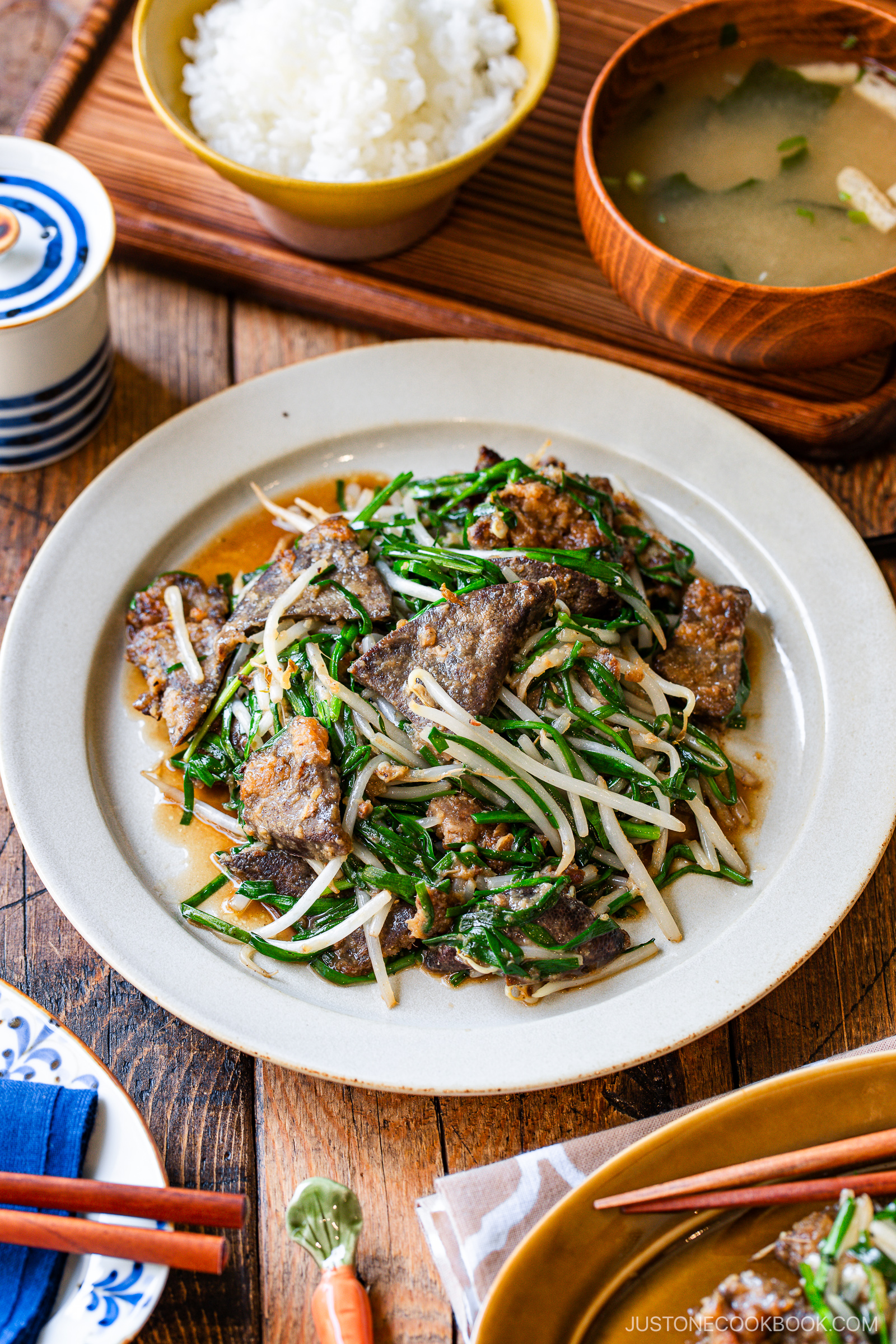
Stir-Fried Pork Liver and Garlic Chives is a flavorful and nutritious side dish that’s popular in gastropubs and Japanese home cooking alike. Thin slices of fresh pork liver soak in a gingery marinade, then sear in a hot pan before tossing in a savory sauce with crunchy bean sprouts and bright green nira.
If you love quick Japanese stir-fries, try my Beef and Green Pepper Stir-Fry, Miso Pork and Eggplant Stir-Fry, and Ginger Pork (Shogayaki) recipes next!
Table of Contents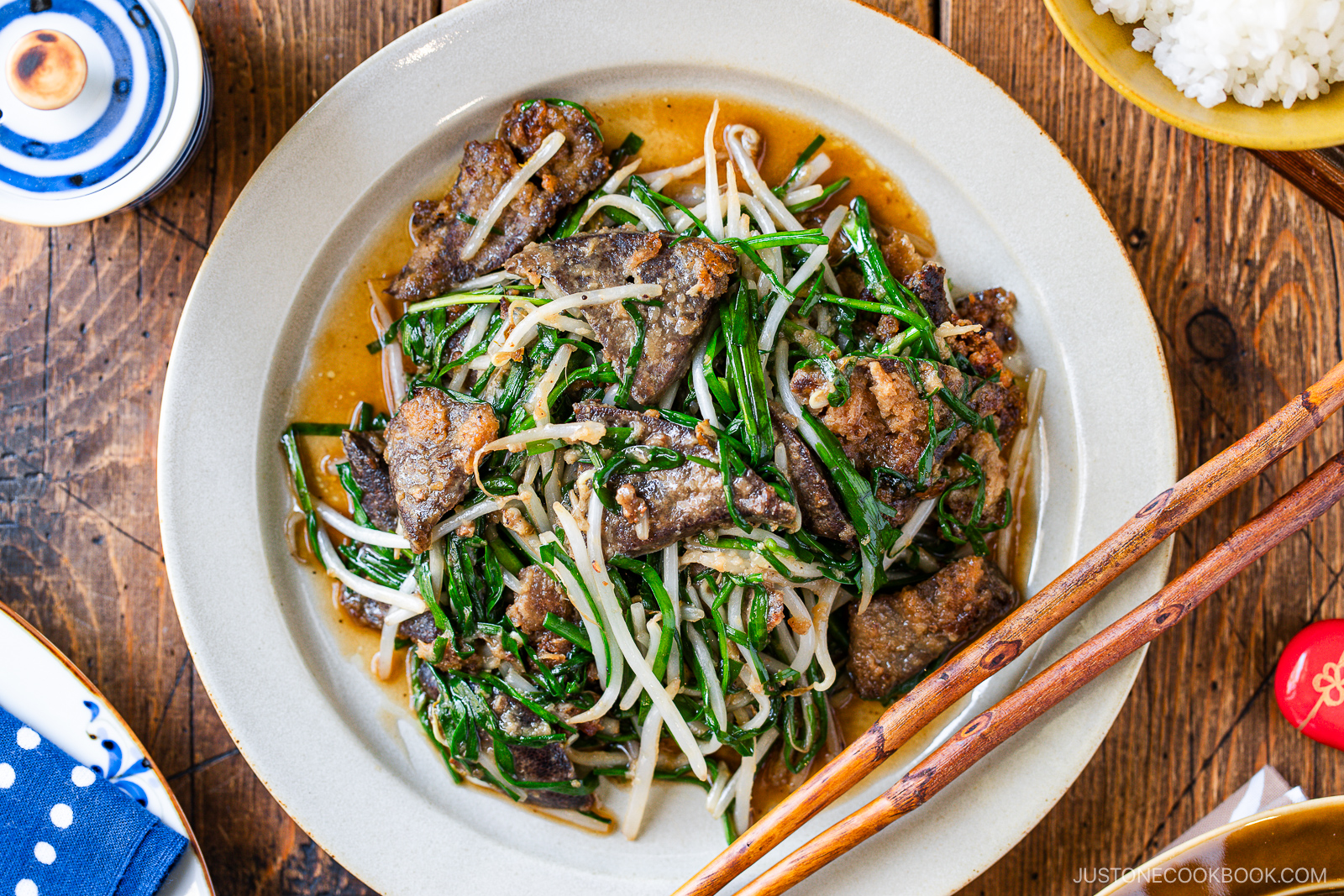
What Is Nira Reba?
Nira Reba (ニラレバ) is a stir-fried dish made with pork liver and garlic chives. It’s a popular teishoku (set meal) served at diners and Chinese-style restaurants across Japan. Loved for being affordable, hearty, and full of nutrients like iron and vitamin B12, it’s often enjoyed as a quick and energizing meal—especially when you’re tired or need a boost.

Why I Love This Recipe
- Bold, savory flavor – The sweet-savory sauce and tender liver go so well with rice. Every bite is so satisfying!
- Nutritious and energizing – Liver is packed with protein, iron, and vitamins. Garlic chives add even more nutrients and flavor. It’s the perfect energy boost!
- Quick and easy – Just slice, stir-fry, and season. Simple and ready in no time!

Ingredients for Stir-Fried Pork Liver and Garlic Chives
- Pork liver
- Ice cubes, cold water, and milk – for rinsing and soaking
- Garlic chives (nira or Chinese chives)
- Bean sprouts
- Ginger
- Garlic
- Soy sauce
- Sake – for the marinade and sauce
- Oyster sauce
- Potato starch
- Toasted sesame oil and neutral oil
Find the printable recipe with measurements below.
Jump to Recipe…Are You New to Cooking Pork Liver?
I was, too! I never cooked this dish when I was in Japan. But after receiving so many requests from readers, I finally stepped out of my comfort zone—I’m so glad I did!
In Japan, pork liver is a popular ingredient because it’s affordable, easy to find, and packed with nutrients like iron, vitamin A, B12, and folate. It has a rich, savory flavor that’s less gamey than beef liver and becomes quite mild when properly prepared—like soaking in milk to remove any strong odor. With its firm yet tender texture, pork liver is perfect for quick stir-fries and pairs well with bold flavors like garlic chives and refreshing textures like bean sprouts.
You can usually find pork liver at Asian grocery stores. I picked mine up at H-Mart!
Substitutions
- Pork liver: If you can’t find it, try chicken liver or mild and tender calf liver. For plant-based alternatives, use thinly sliced tofu varieties such as firm tofu, koyadofu (rehydrated dried tofu), or aburaage (deep-fried tofu pouch).
- Potato starch: If you don’t have it, use cornstarch or rice flour.
- Oyster sauce: If you‘re allergic to shellfish, use a few tablespoons of Lee Kum Kee Vegetarian Stir-Fry Sauce.
- Soy sauce: Use tamari soy sauce for gluten-free.
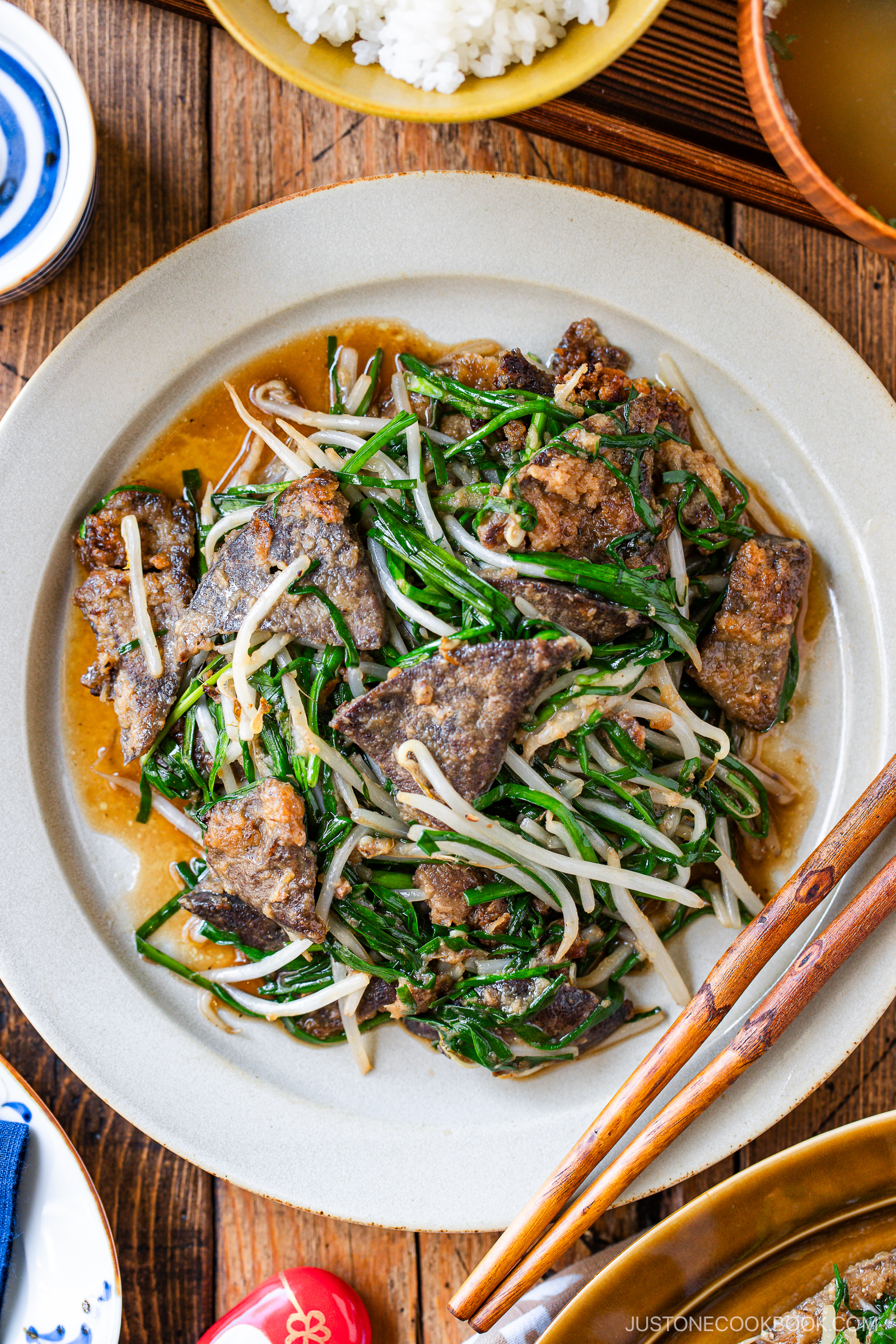
How to Make Stir-Fried Pork Liver and Garlic Chives
Preparation
- Clean. Cut into thin slices. Swish in a bowl of ice water several times. Soak the liver slices briefly in ice water, then in milk. Pat dry with paper towels.
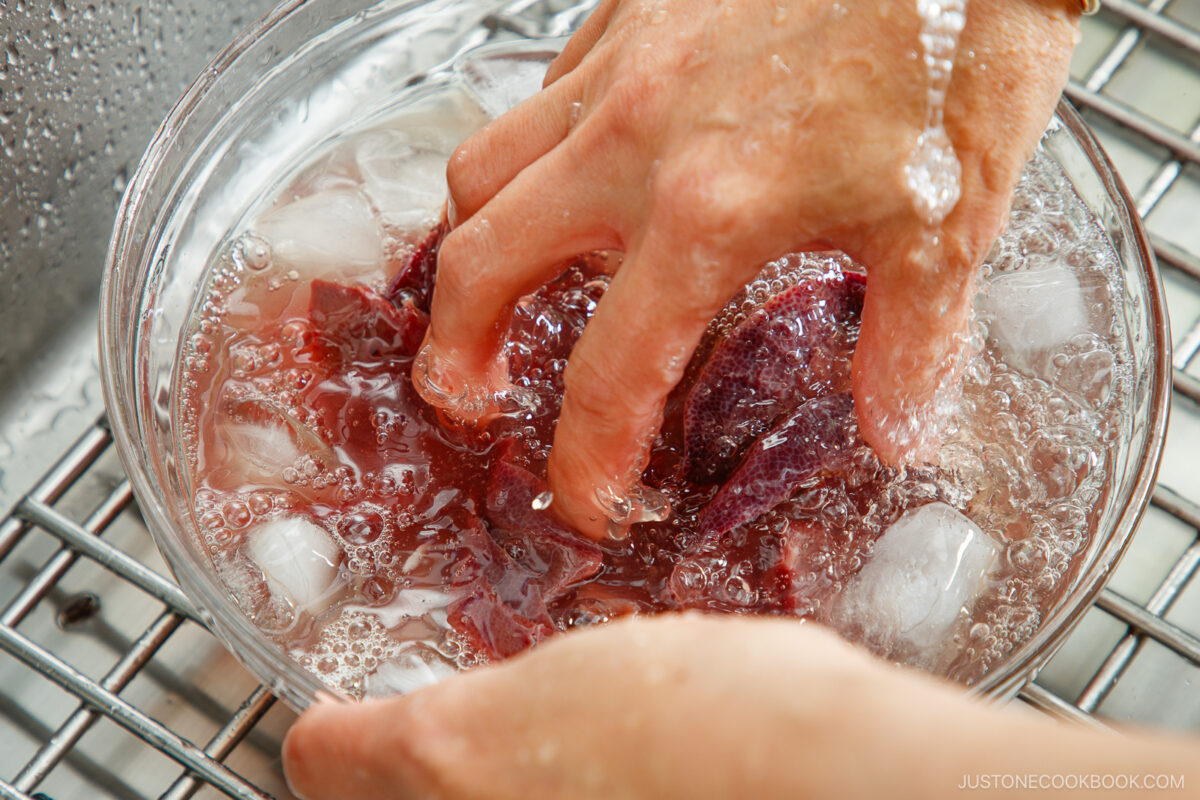
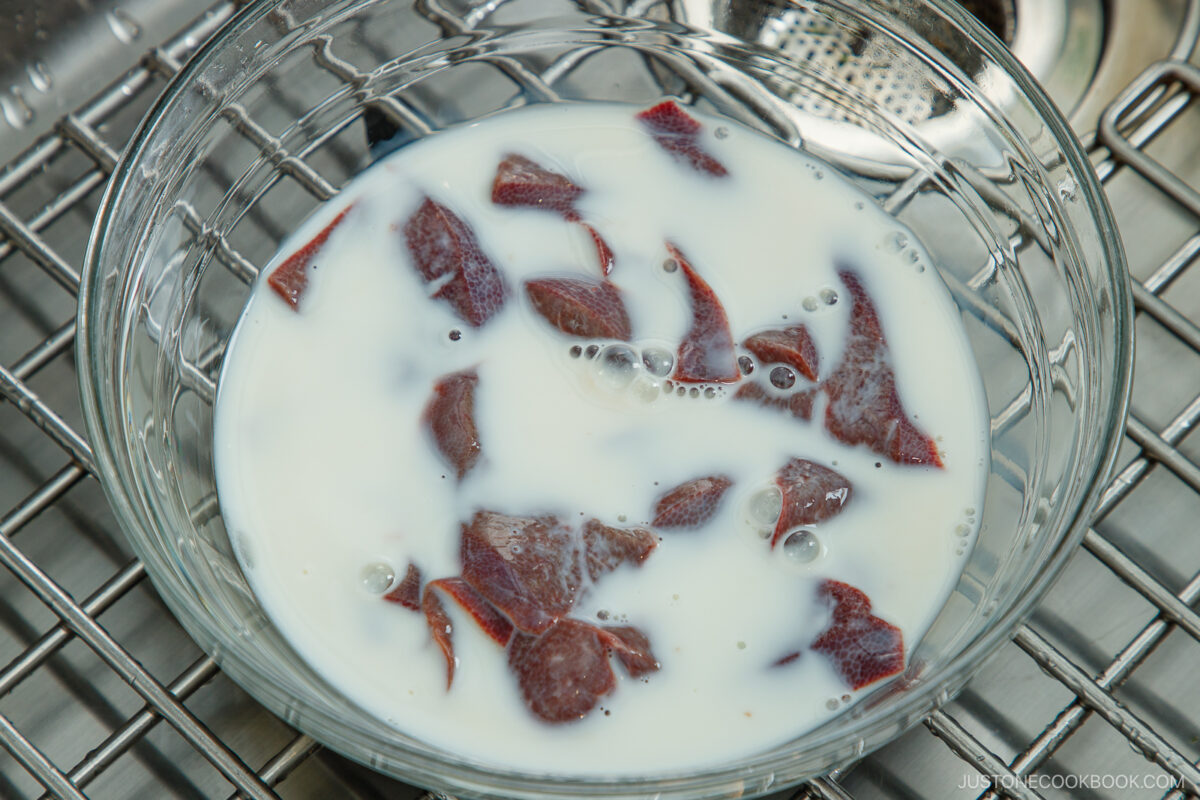
- Marinate. Mix grated ginger, grated garlic, sake, and soy sauce. Coat the liver and chill in the fridge for 10 minutes.
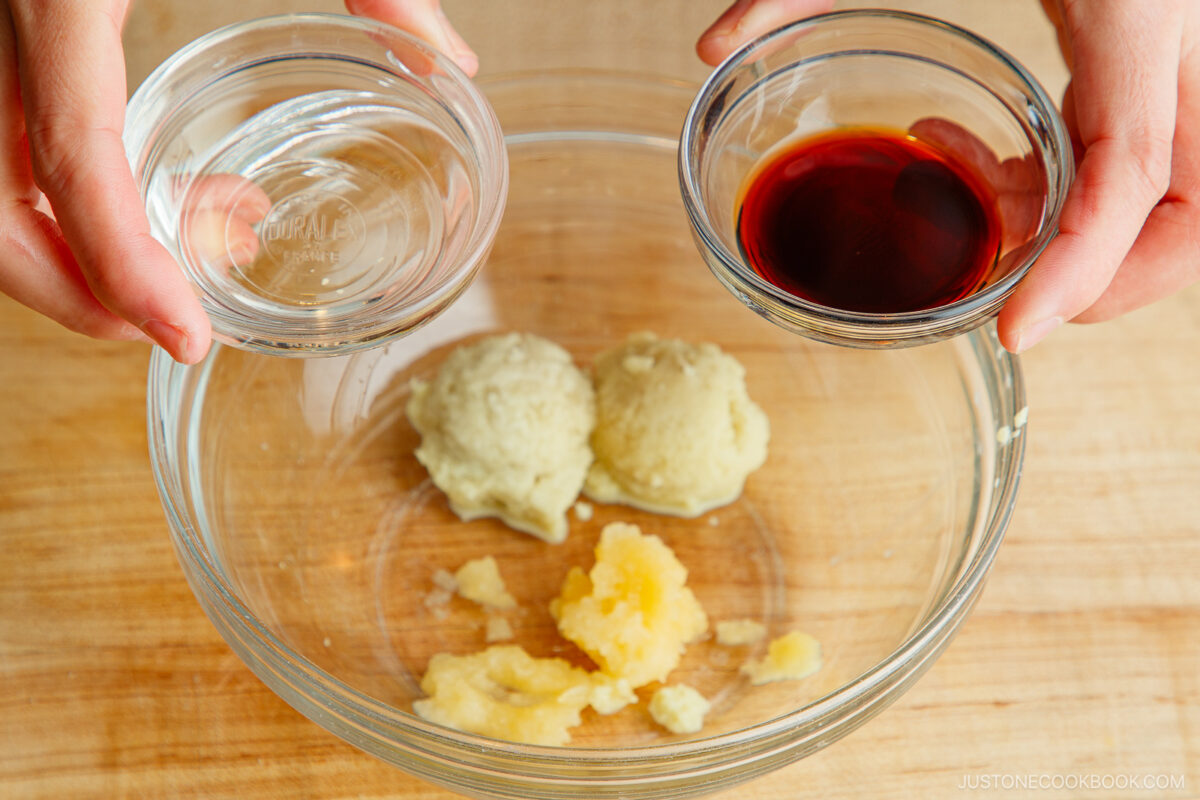
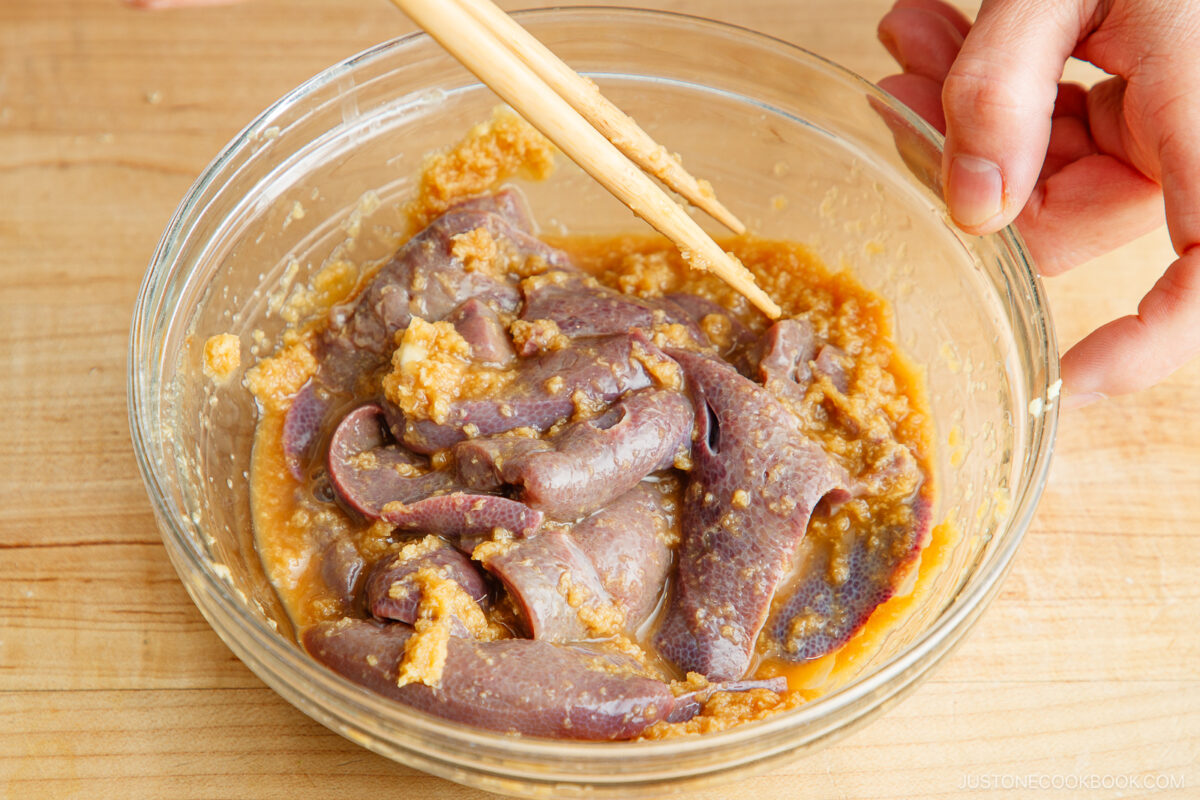
- Prep the vegetables and seasonings. Cut the bunch of chives into 1½-inch lengths; rinse and drain the bean sprouts. Combine the seasonings.
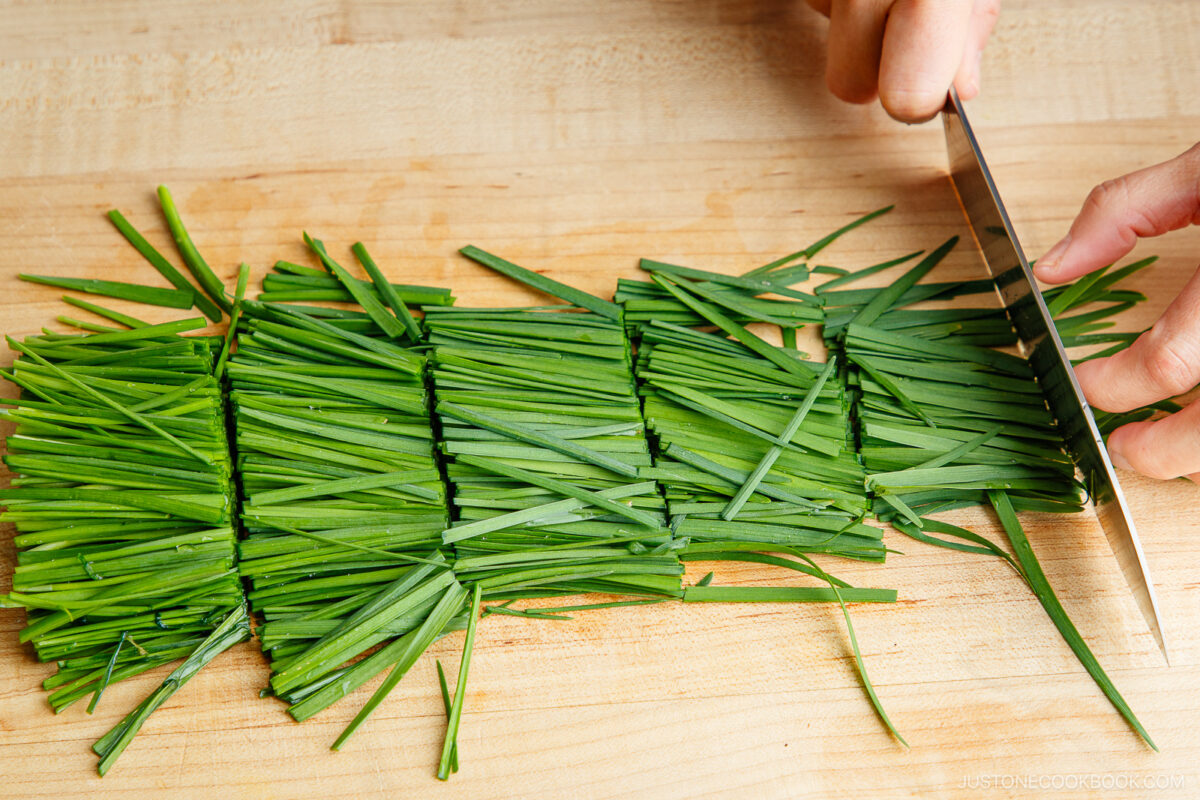
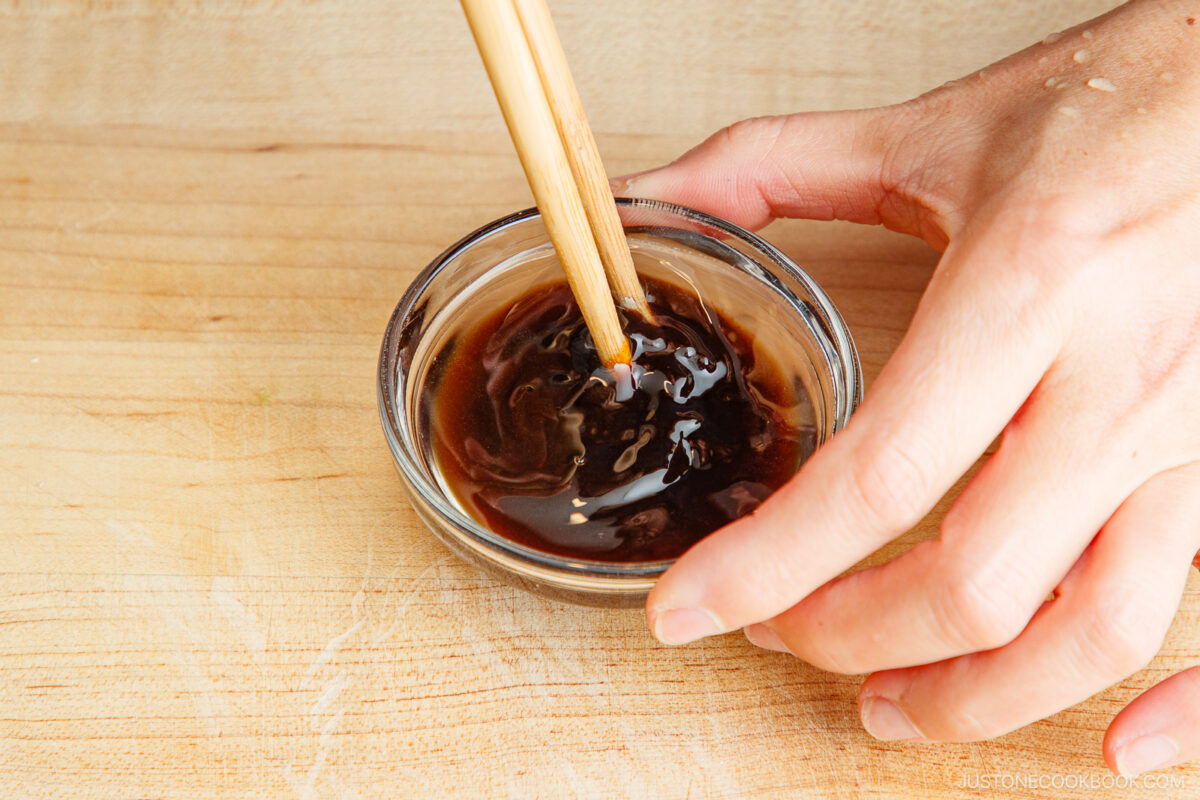
Cooking
- Coat and sear. Dust each liver slice lightly with potato starch. Cook in a frying pan until browned on both sides and the center reaches 160°F (74°C). Transfer to a plate.
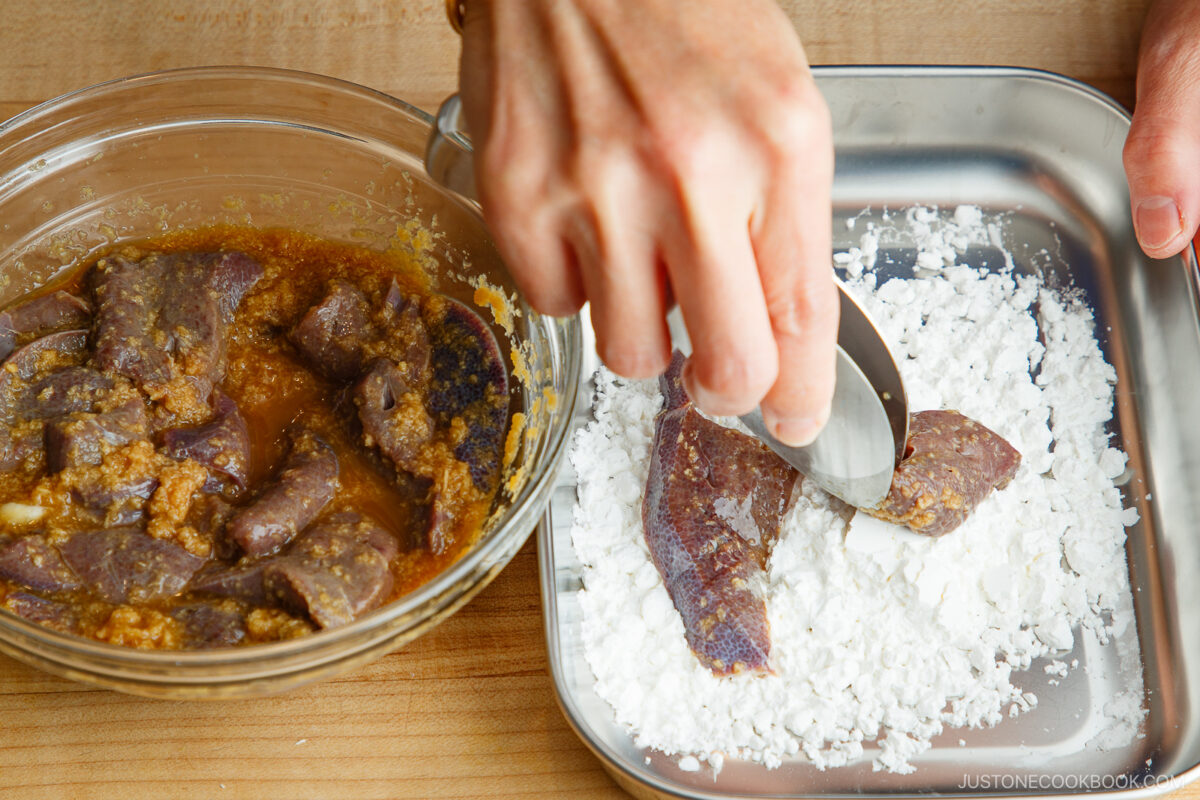
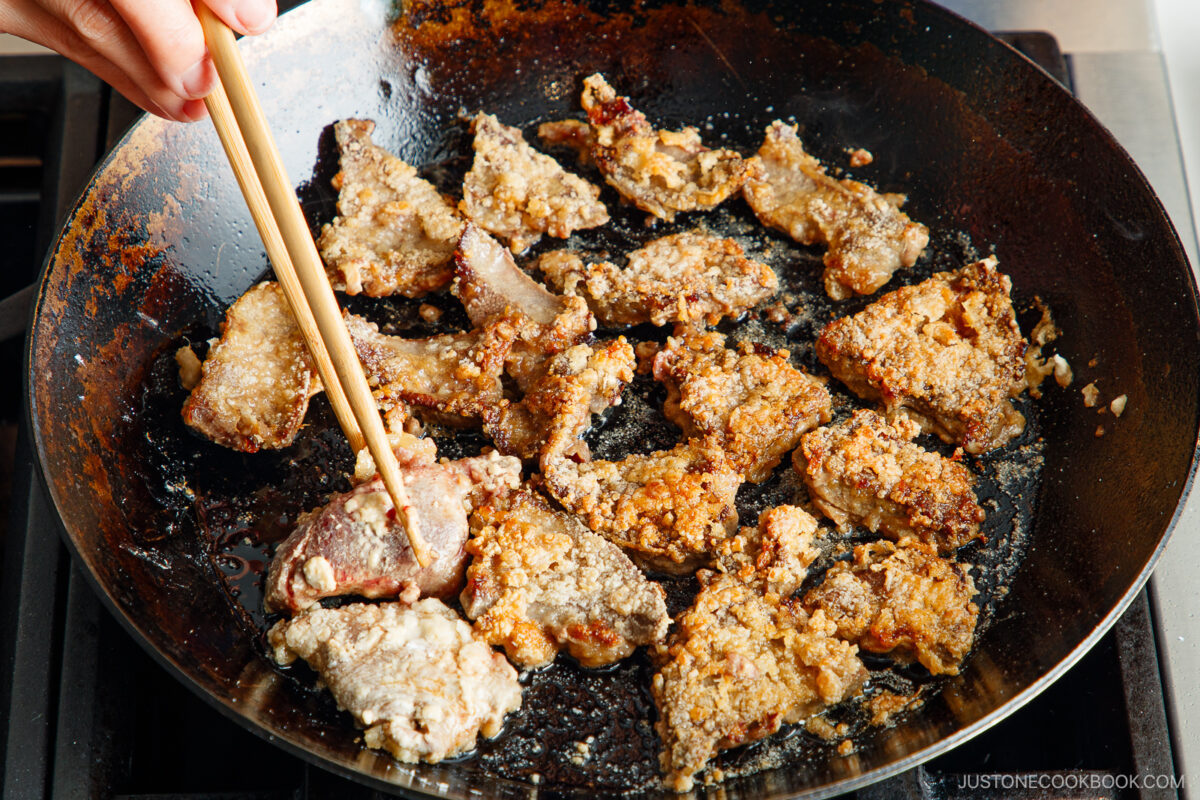
- Stir-fry the veggies. Quickly fry the garlic chives and bean sprouts in sesame oil. Cook the reserved marinade in the pan.
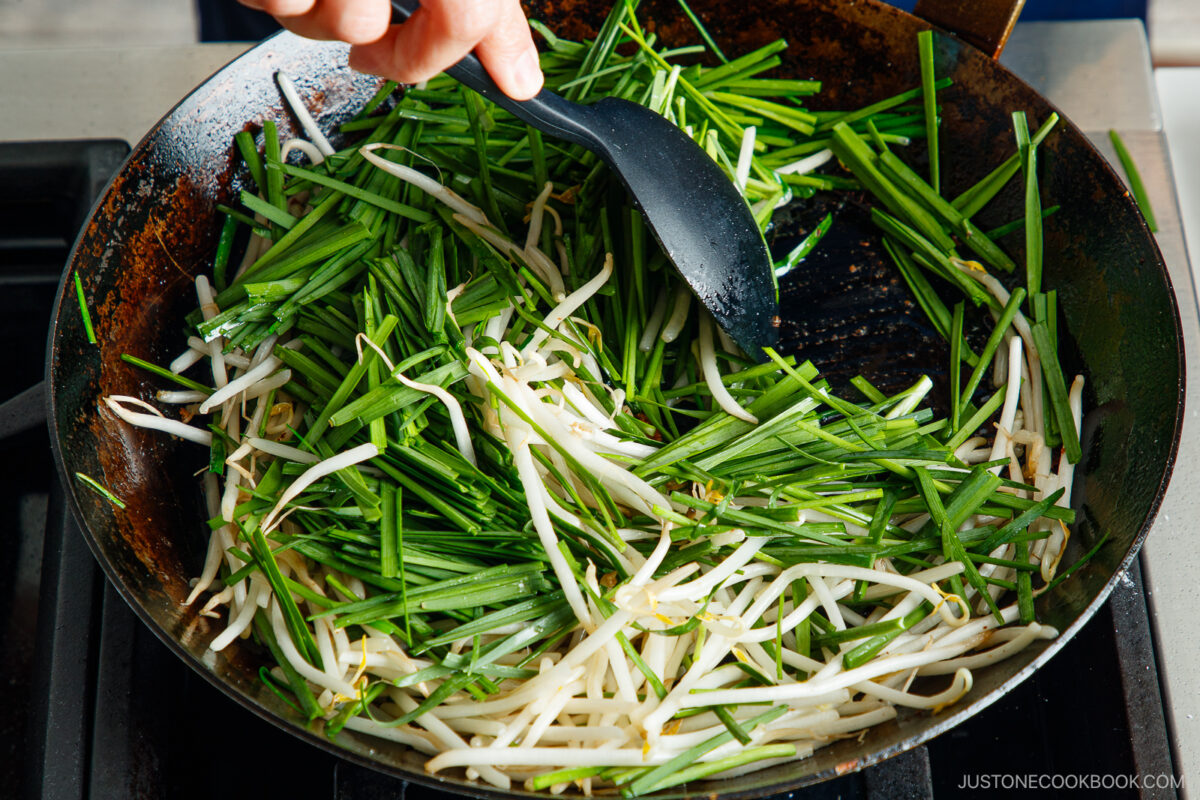
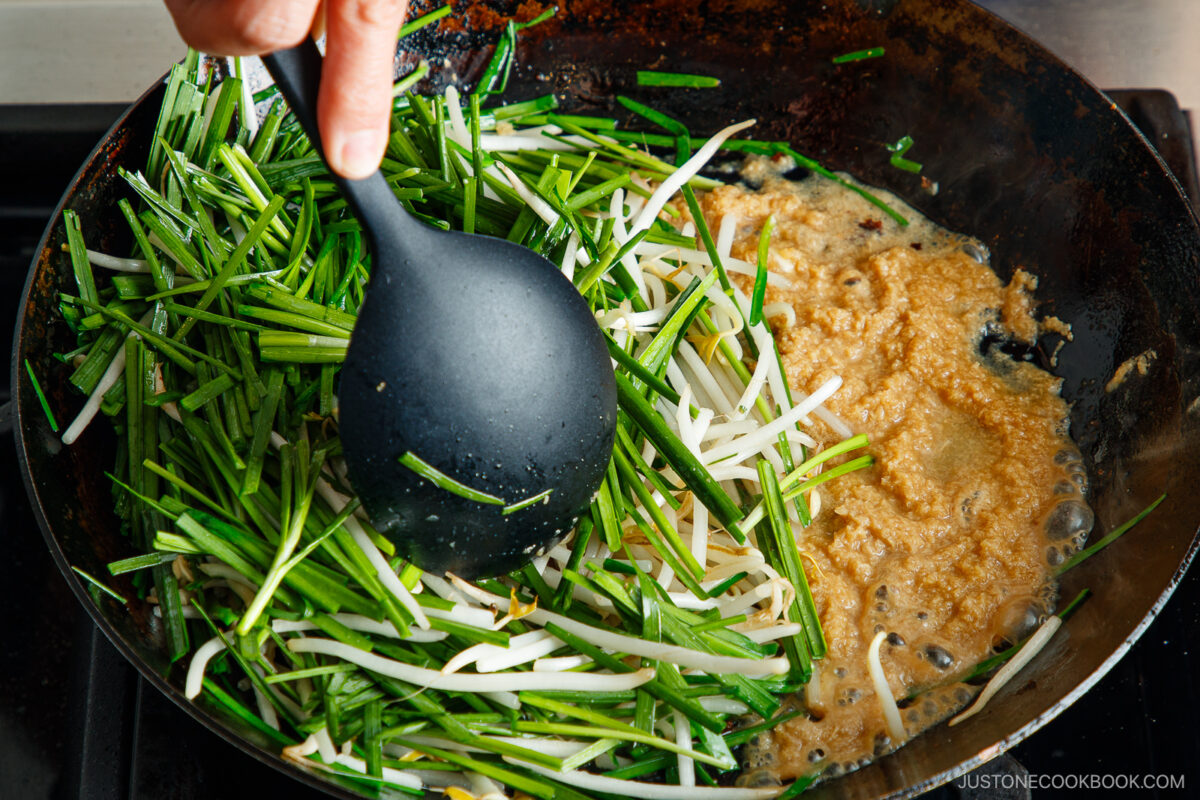
- Combine. Add the liver and sauce, and toss just until coated.
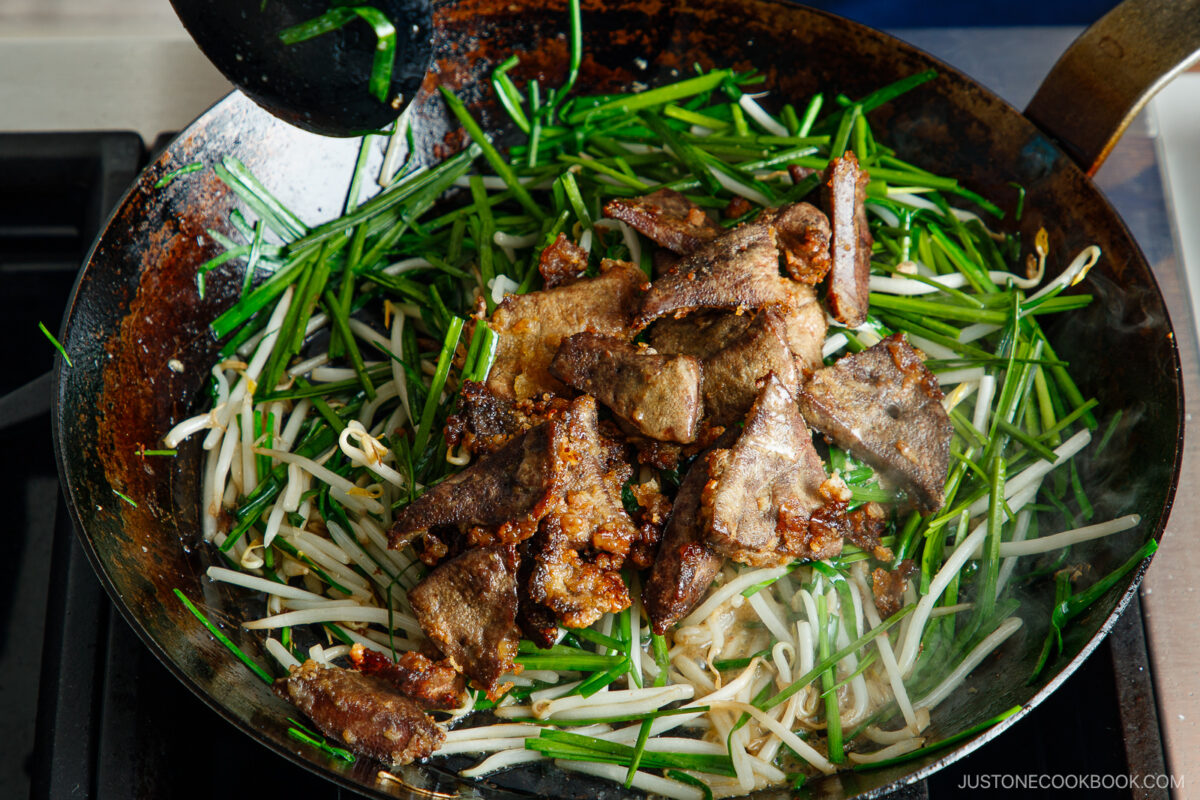
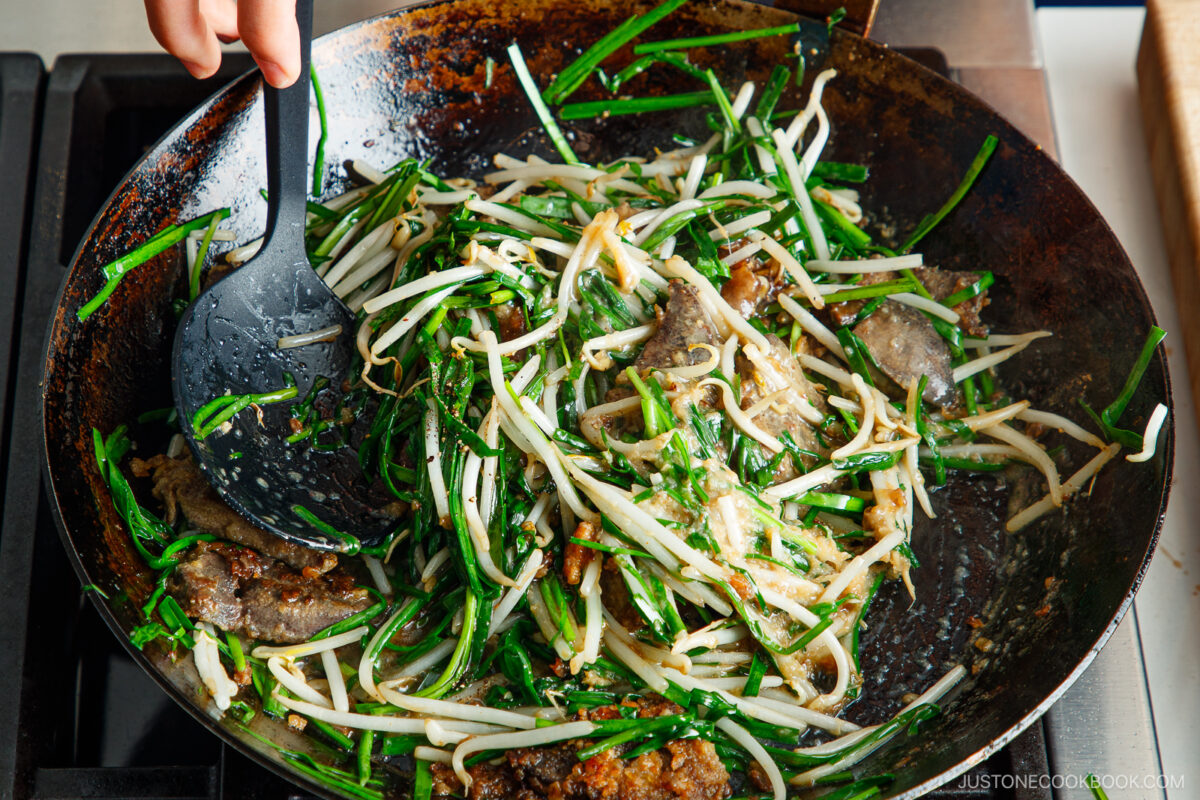
- Serve immediately with white pepper powder at the table.
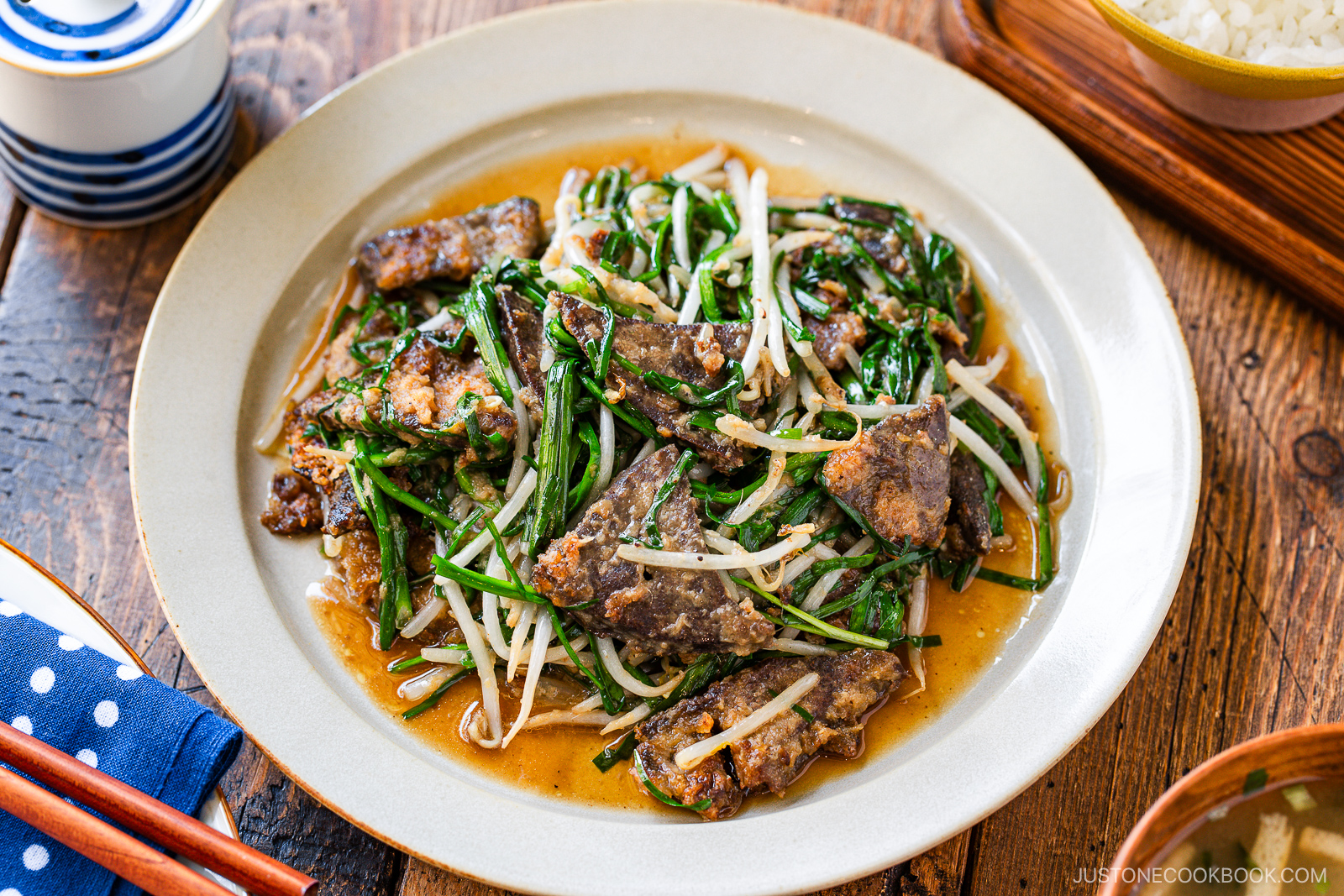
Nami’s Recipe Tips
- Choose fresh pork liver – Look for a bright red color and glossy sheen.
- Rinse well and soak – Soaking in ice water removes excess blood; soaking in milk eliminates odor.
- Use a light starch coating – Too much potato starch makes the surface gummy; a whisper-thin dusting locks in juices and seasoning.
- Sear, don’t steam – Leave space between slices so they brown instead of steaming. Work in batches if needed.
- Flip the liver when you see the liquid – As soon as red liquid seeps out and pieces release easily from the pan, flip them. Waiting too long can make the coating soggy and cause it to fall off.
- Check the temperature – An instant-read thermometer ensures the center reaches 160–165°F (71–74°C) without overcooking.
- Serve right away – Bean sprouts lose their crunch if they sit, so bring the dish to the table immediately.
Variations and Customizations
- Add sliced onions. Brown them quickly in a very hot pan to develop a charred flavor.
- Bulk up with vegetables. For more color, fiber, and freshness, toss in other crunchy vegetables like green peppers, red bell peppers, and snow peas.
- Spice it up. Punch up the heat and flavor with chiles.
What to Serve with Stir-Fried Pork Liver and Garlic Chives
- Japanese Potato Salad
- Tossed green salad drizzled with Japanese Onion Dressing
- Japanese Spinach Salad with Sesame Dressing
- Bacon and Asparagus Miso Soup
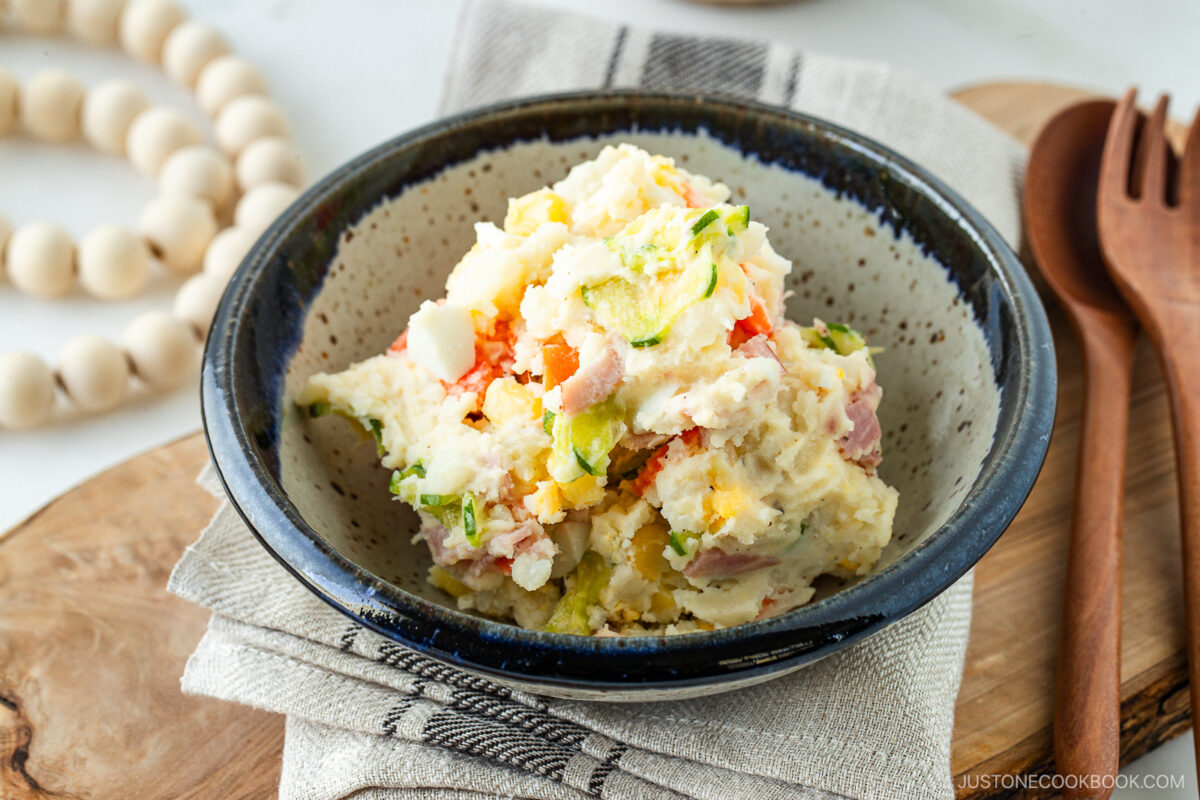
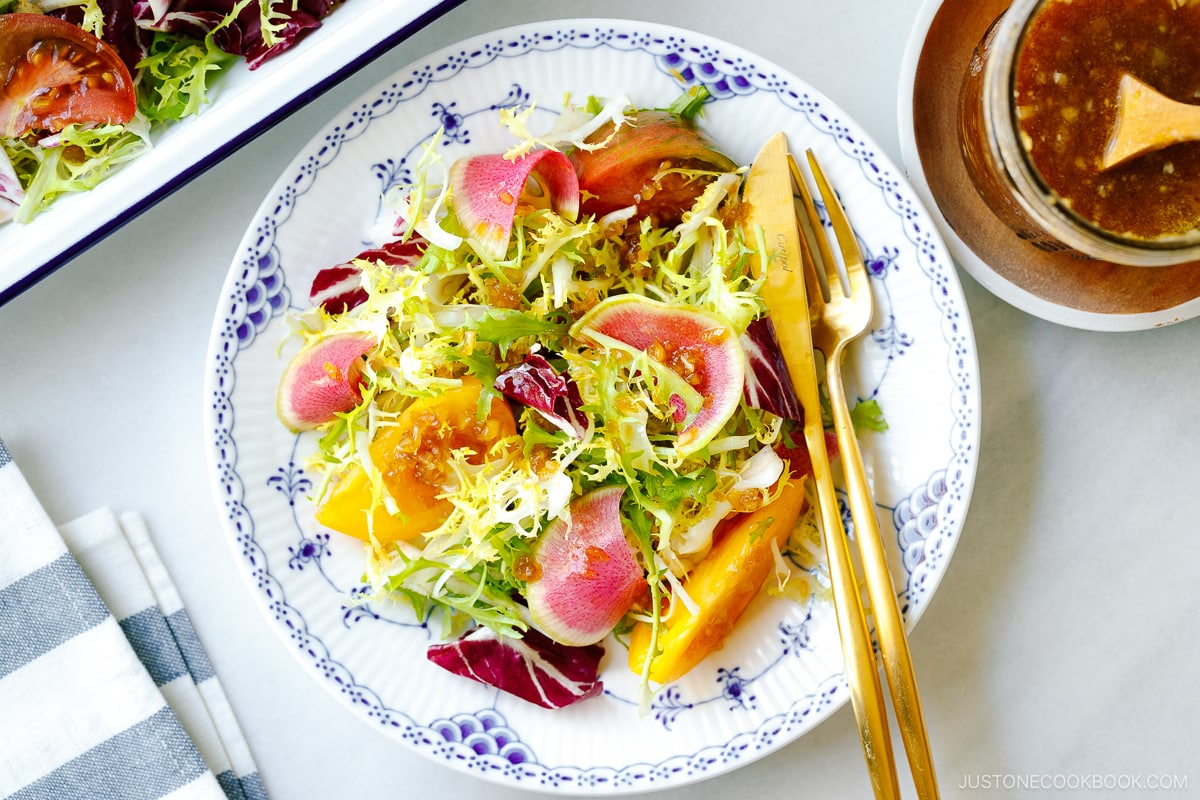
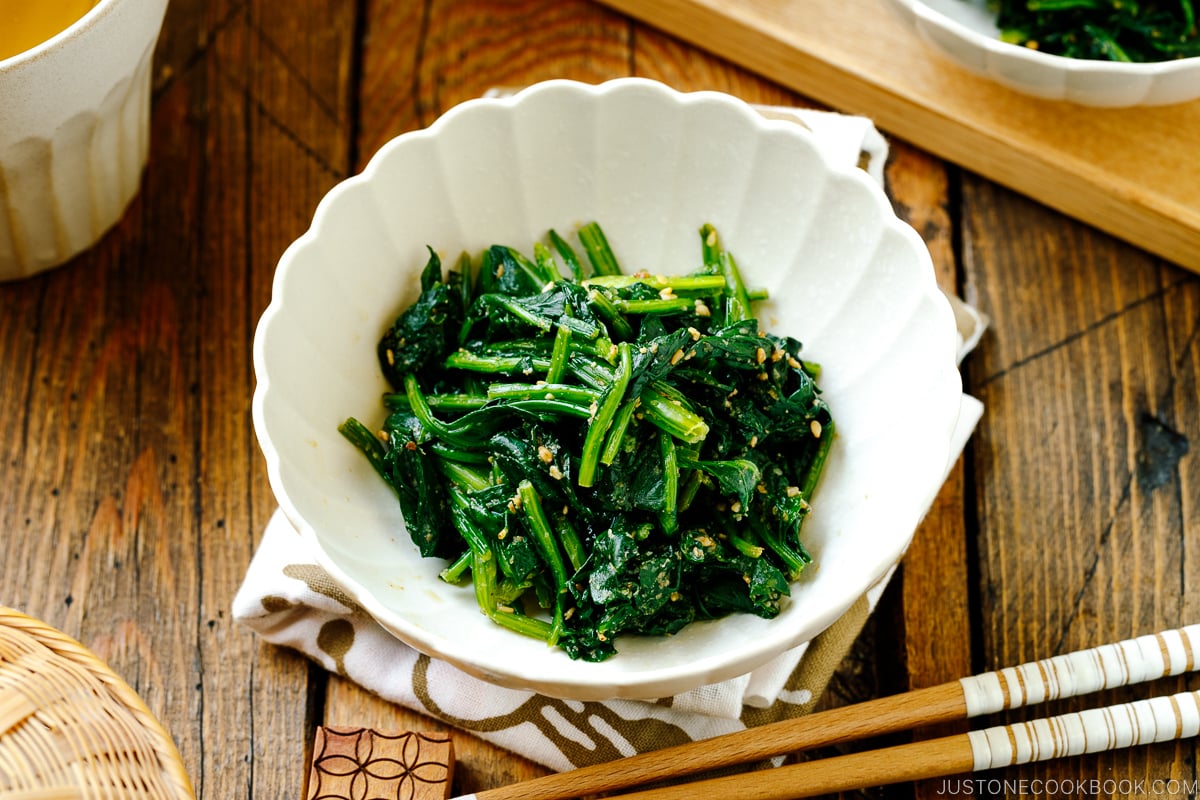
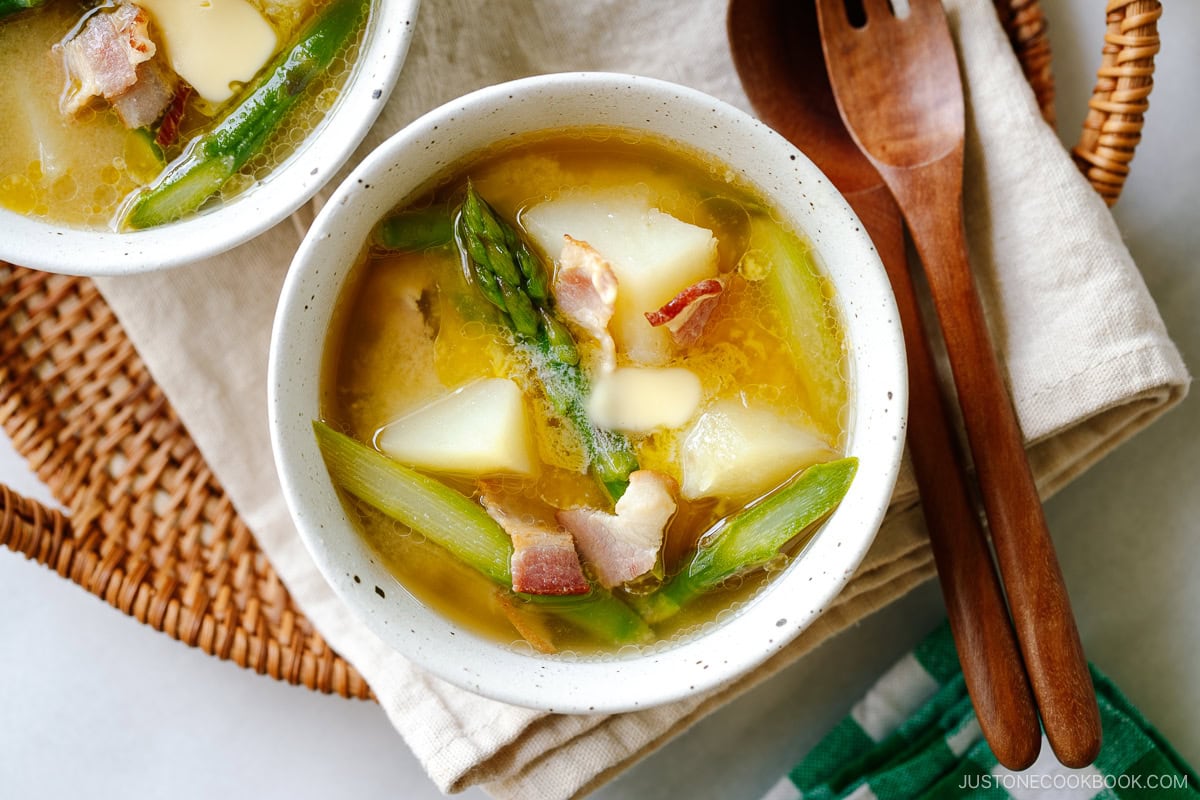
Storage and Reheating Tips
To store: Refrigerate the leftovers in an airtight container for up to 2–3 days.
To reheat: Warm gently in a skillet over medium heat until hot. Avoid microwaving, which can toughen the liver.
Frequently Asked Questions
Can I substitute green onions for the garlic chives?
You could, although the flavor of scallions is sharper than mild garlic chives.
Should I season the pork liver with a teaspoon of salt and pepper?
The marinade contains all the seasoning you need, so you don’t need to add additional salt or pepper.
Can I use vegetable oil?
Vegetable oils have a neutral flavor and high smoke point, so you can use them for this recipe. Read more about them in my article Best Neutral Oil for Cooking.
For the Marinade
For Serving
- white pepper powder (optional)
Gather all the ingredients. Prepare 2 cups ice cubes in a medium bowl.
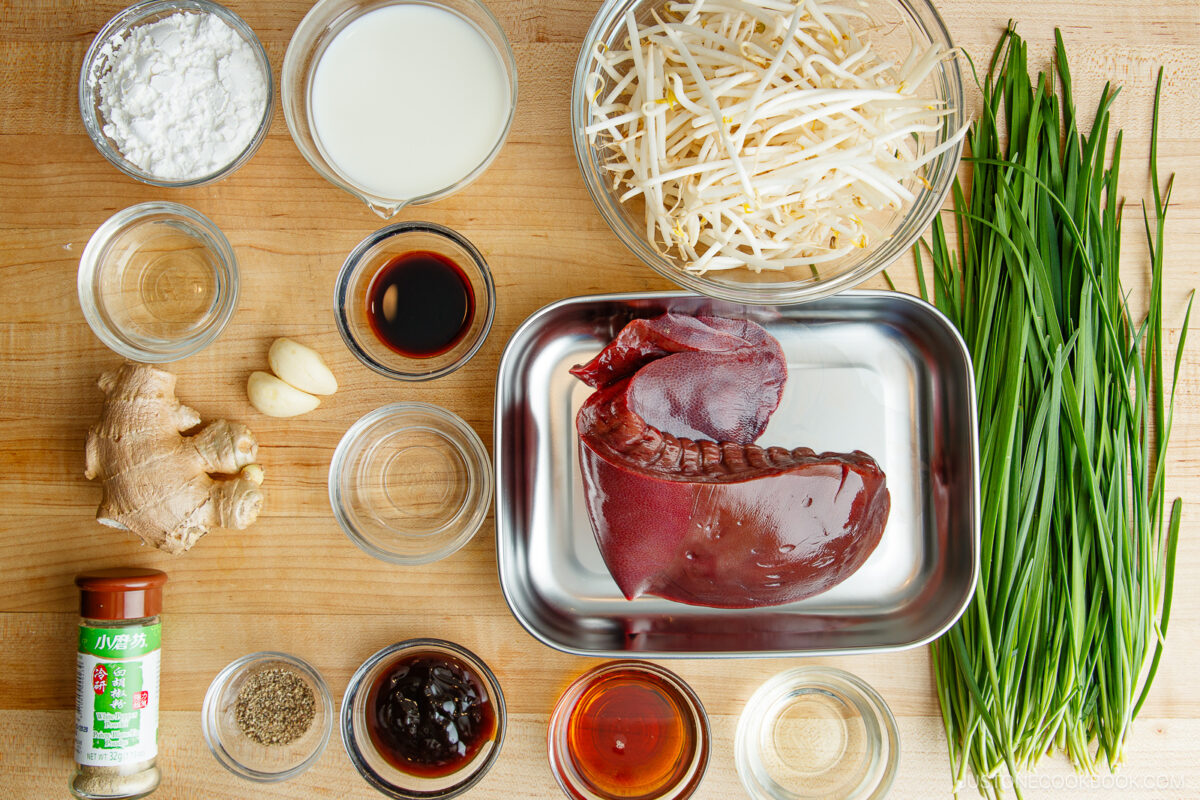
To Prepare the Pork Liver
Slice: Trim off the white sinew and any blood clots from ½ lb pork liver. Thinly slice the liver crosswise about ⅜ inch (8 mm–1 cm) thick. Cut them into bite-sized pieces, if needed. As you slice, add the pieces to the ice-filled bowl. Total weight should be about 8 oz or 225 g.
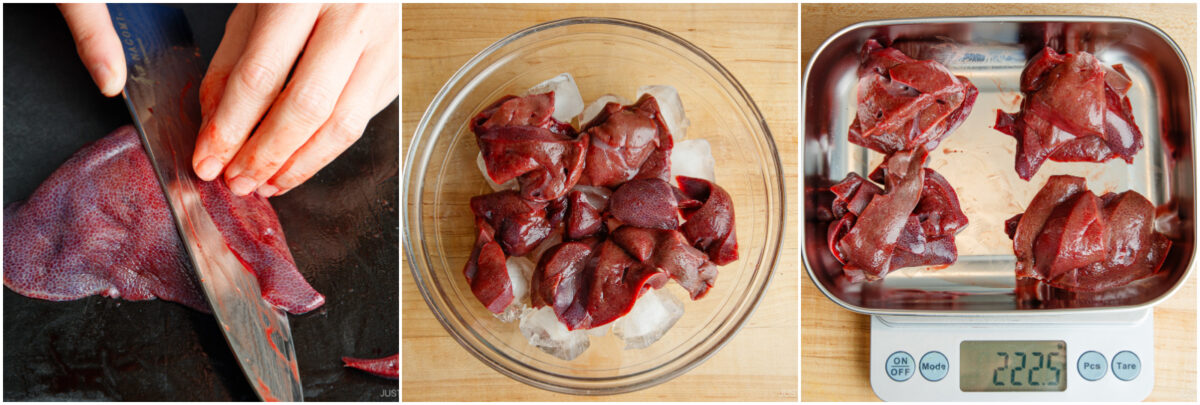
Rinse: Add cold water and rinse the liver, then pour off the water. Repeat several times until the water runs clear. Nami's Tip: Don't skip these rinsing and soaking steps; it makes a big difference in the final taste and texture.
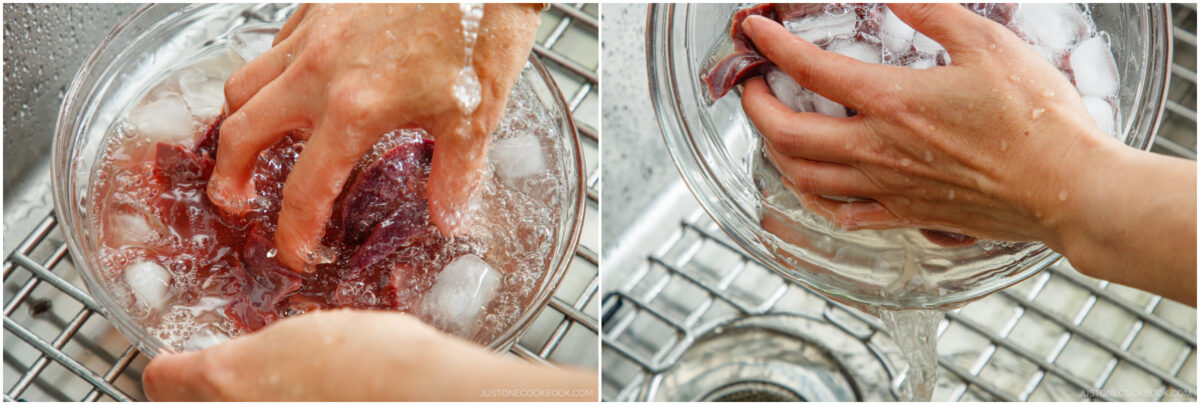
Soak in ice water: Add more cold water and soak the liver in ice water for 10 minutes to remove excess blood. If the water gets murky or changes color, replace it with fresh cold water.
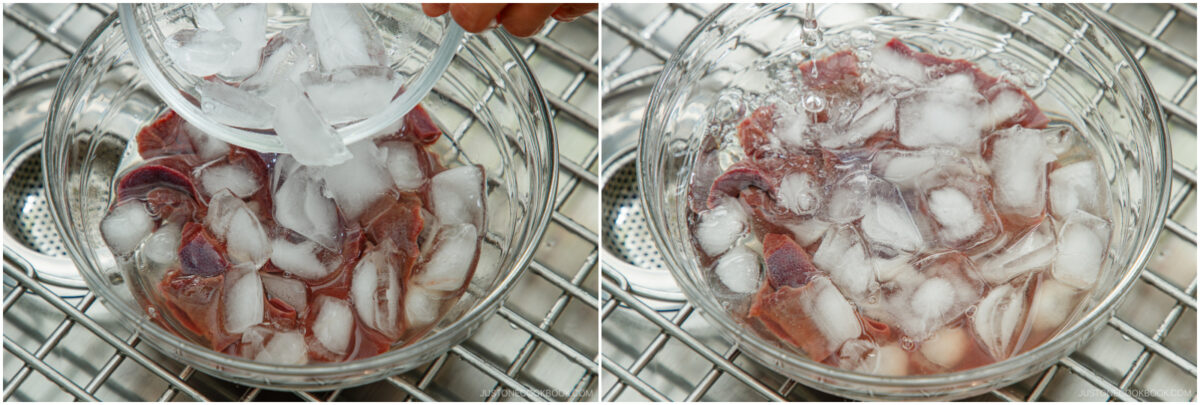
Drain the liver in a colander and shake off any excess water.
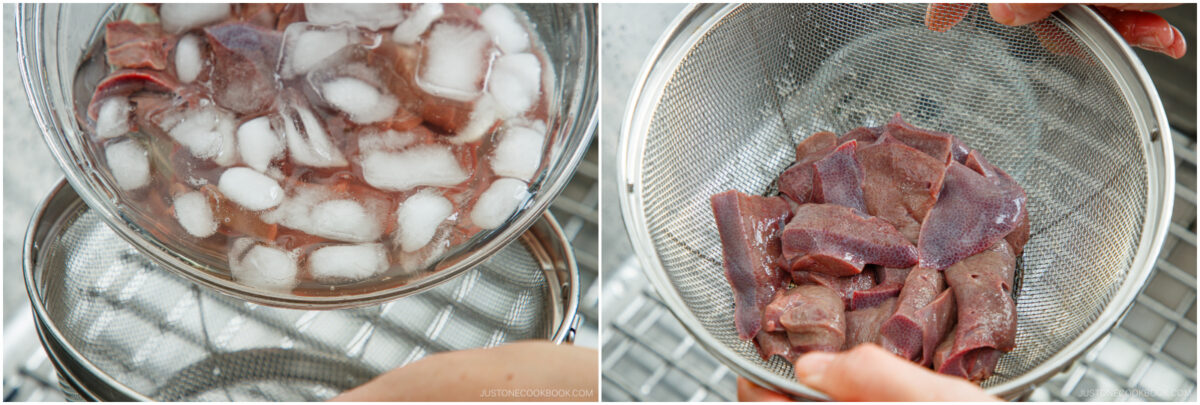
Soak in milk: Place the liver in a clean bowl and add about ½ cup milk or enough to cover. Soak for 20 minutes to remove odor. If you live in a warm climate, keep it in the fridge.
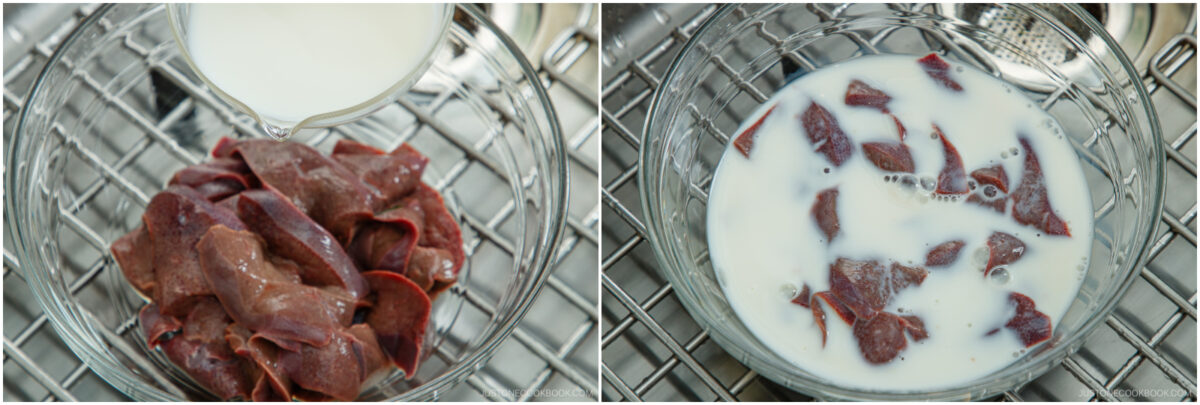
To Marinate
Meanwhile, grate 2 inches ginger and measure 2 Tbsp grated ginger with juice. Grate 2 cloves garlic and measure 1 tsp grated garlic.
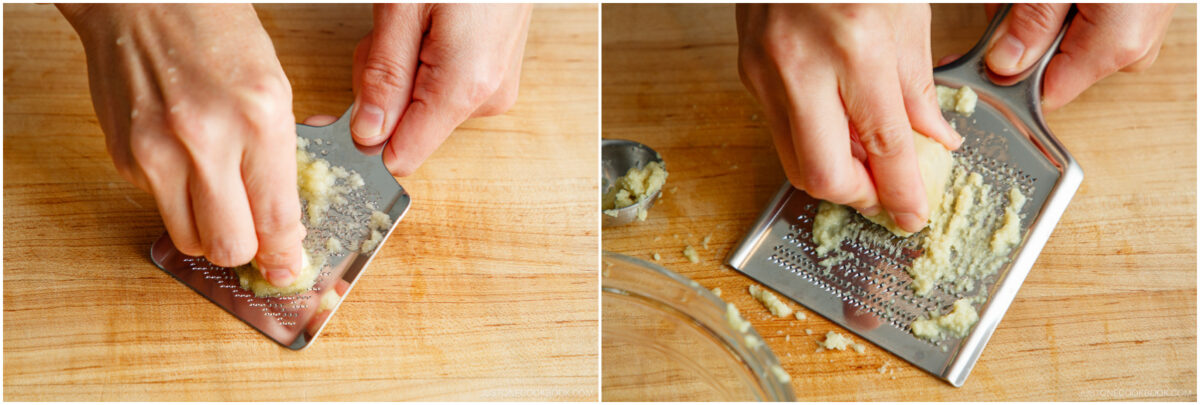
In a clean medium bowl, combine the grated ginger, grated garlic, 2 Tbsp sake, and 2 tsp soy sauce.

After 20 minutes of soaking, lightly rinse the liver in water.
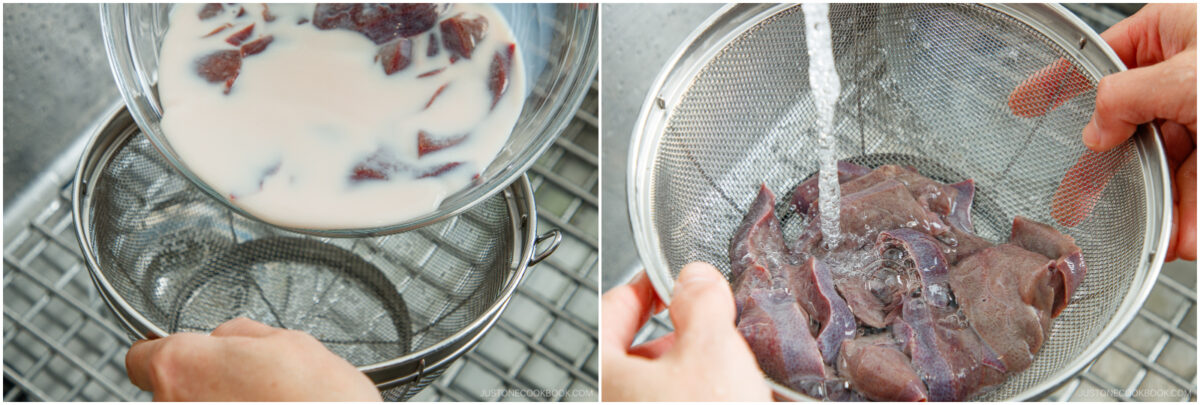
Pat dry with paper towels.
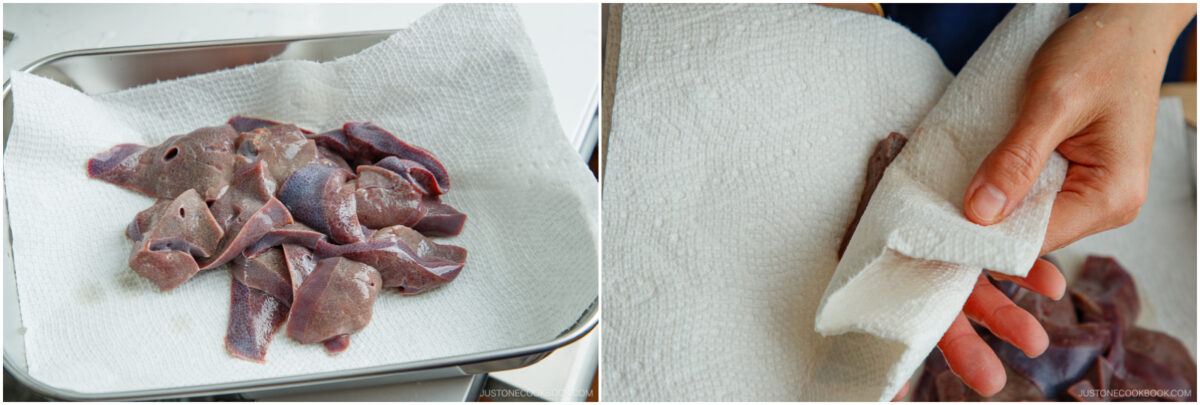
Add the liver to the marinade and coat well. Let it marinate in the fridge for 10 minutes.
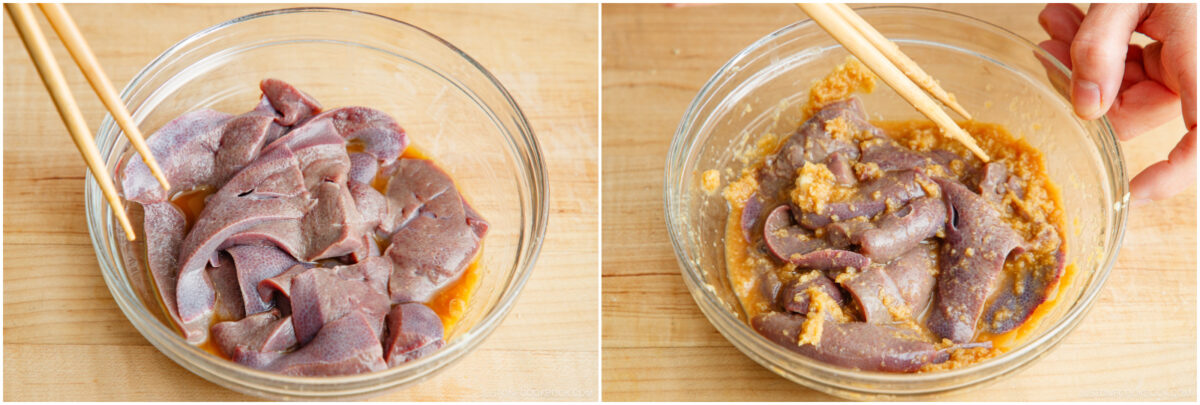
To Prepare the Vegetables and Sauce
Meanwhile, cut off the root ends of 4 oz garlic chives (Chinese chives or Nira) and cut into 1½-inch (4-cm) lengths. Rinse ⅓ bag bean sprouts and drain in a colander. I set aside the tougher ends of garlic chives with the bean sprouts, as I'll cook them first.
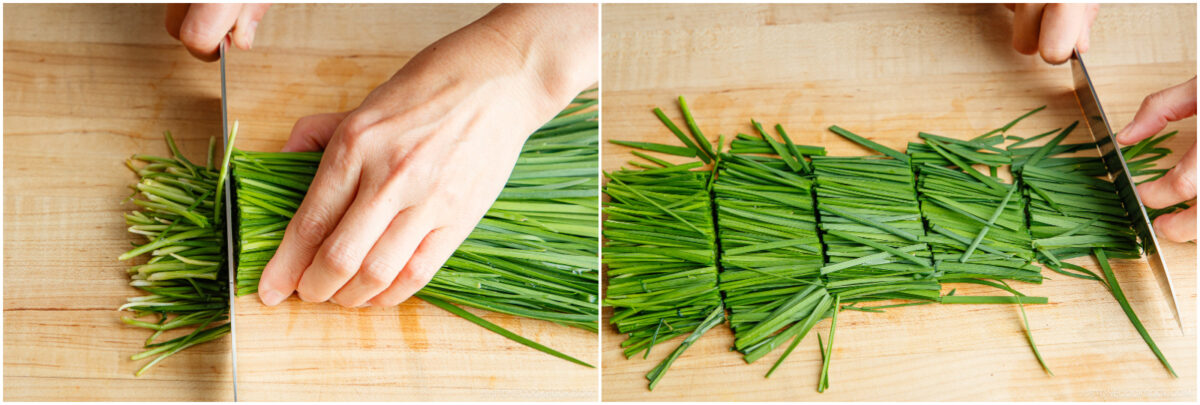
Mix 2 Tbsp oyster sauce and 1 Tbsp sake in a small bowl for the seasoning sauce. Set aside.
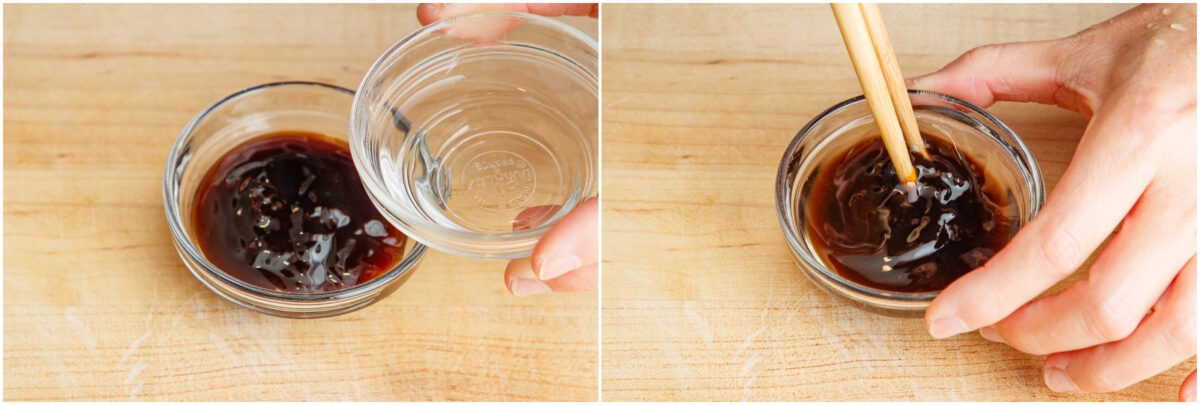
To Sear the Pork Liver
Prepare ½ cup potato starch on a tray. Remove the liver from the marinade and lightly coat with starch. Shake off any excess. Reserve the leftover marinade to cook later. Nami's Tip: Avoid using too much starch, which could ruin the liver's texture. You only need a light dusting to lock in the juices and seasonings when frying.
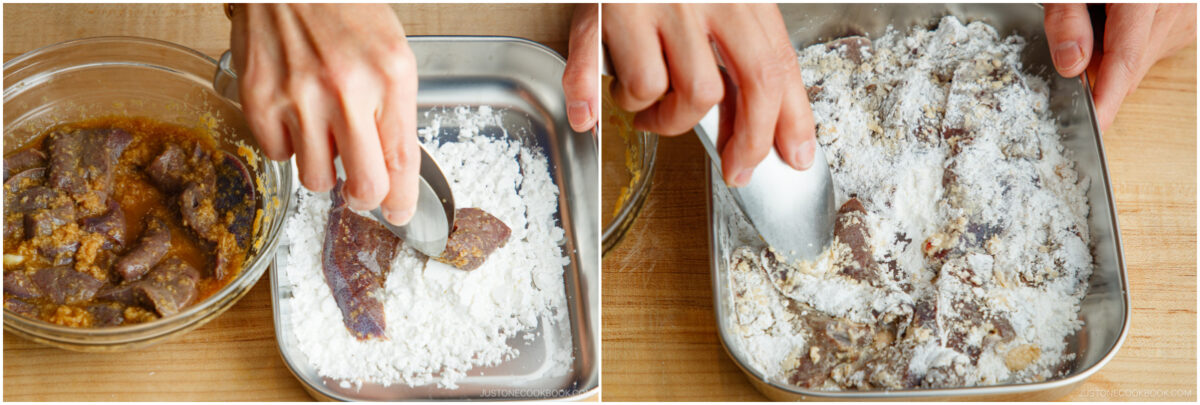
Preheat a large frying pan over medium heat. When it's hot, add 2 Tbsp neutral oil and 1 Tbsp sesame oil.
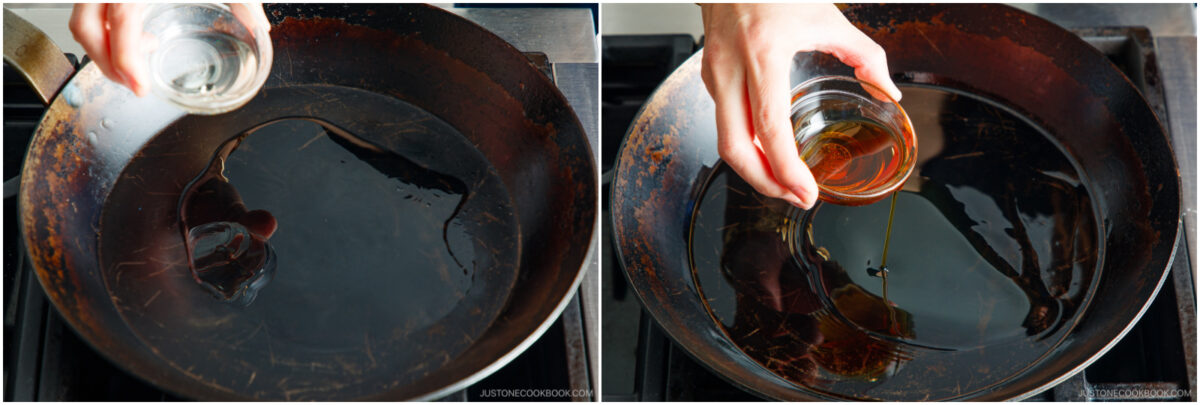
When the oil is hot, add the liver in a single layer and fry in batches as needed. Nami’s Tip: Give each piece enough space in the pan so air can circulate and the surface browns nicely. If the pan is too crowded, the liver will steam instead.
Sear the first side for about 3–4 minutes, until the bottom is lightly browned. When you see red liquid on the surface and the liver lifts easily, flip to sear the other side. Nami’s Tip: Don’t wait too long to flip, or the coating can turn soggy and might peel off.
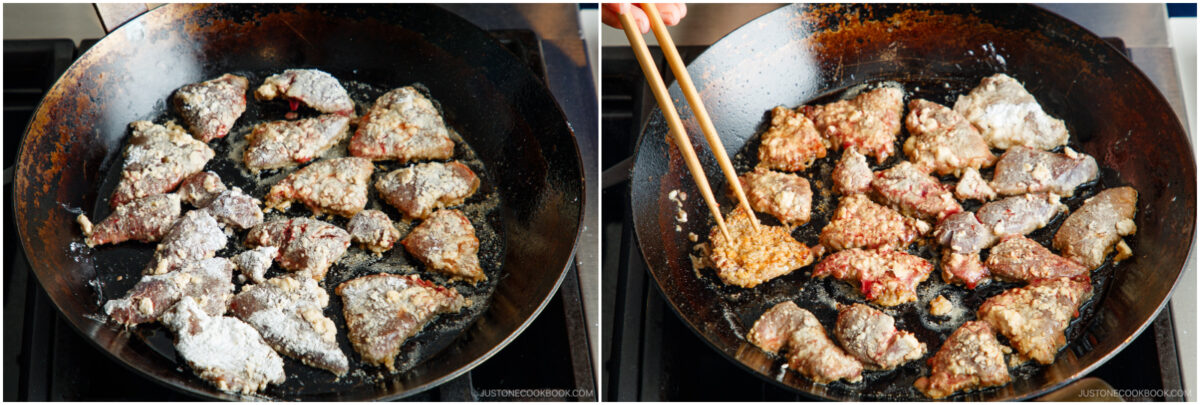
Cook the second side for another 3–4 minutes, until the internal temperature reaches 160–165°F (71–73ºC). If you notice any red spots or the pieces start to curl, gently press them down with a spatula so they cook evenly. Transfer the liver to a tray or plate. Nami’s Tip: Use an instant-read thermometer to make sure the liver is cooked through. The inside should be grayish-brown. Be careful not to overcook, or the liver will turn tough and dry.
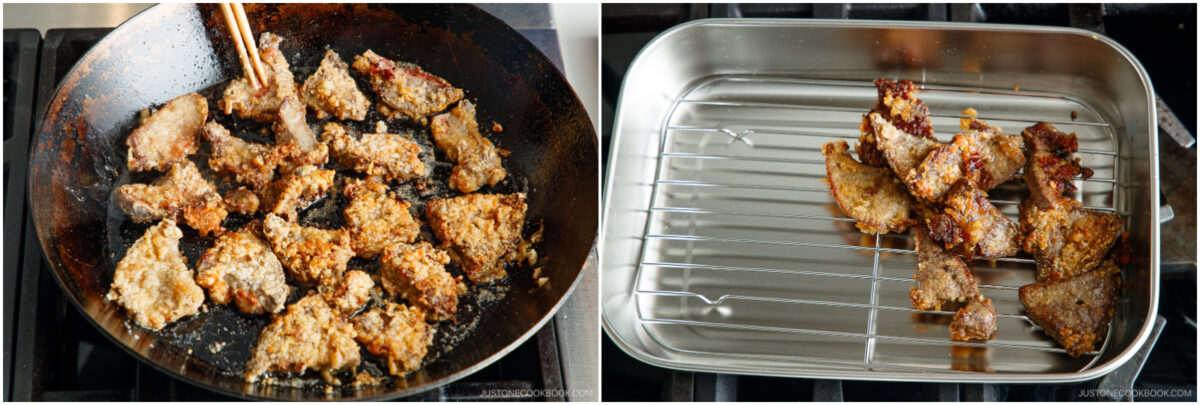
To Stir-Fry the Vegetables and Combine
Keep the heat on medium and add 1 Tbsp sesame oil to the same pan. When the oil is hot, add the tougher ends of garlic chives and bean sprouts and quickly coat with the oil.

Now add the rest of the garlic chives and stir-fry all together for 30 seconds.
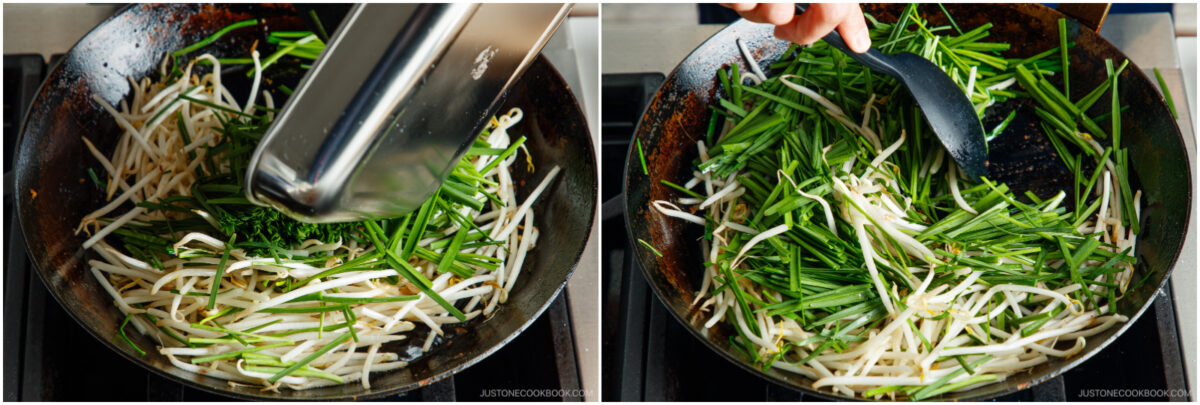
Before the vegetables wilt completely, push them to the sides of the pan. Pour the reserved marinade (including ginger and garlic) into the center or edge of the pan, let it boil, and cook it through first, about 1 minute. Once fully cooked, mix with the vegetables. Nami's Tip: This step is important for food safety since the marinade was used with raw liver. The marinade adds great flavor!
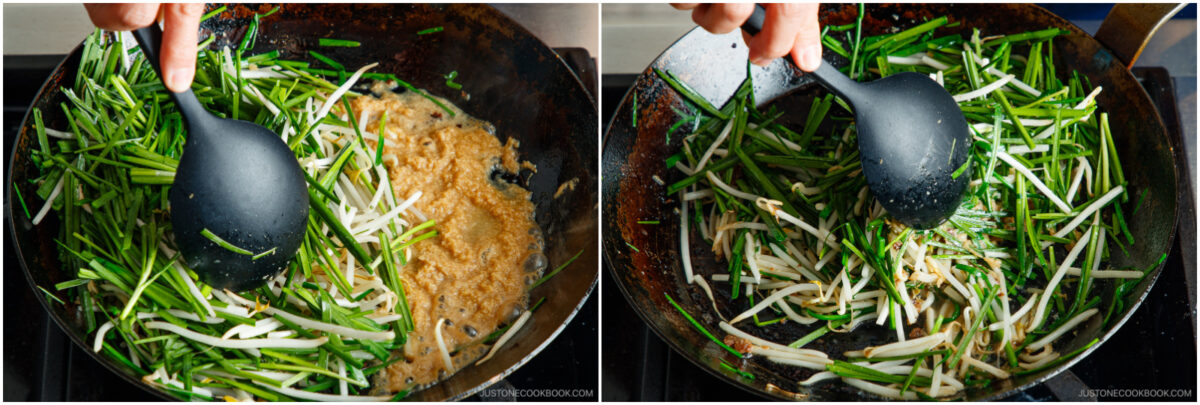
Add the fried liver, the seasoning sauce, and ⅛ tsp freshly ground black pepper.
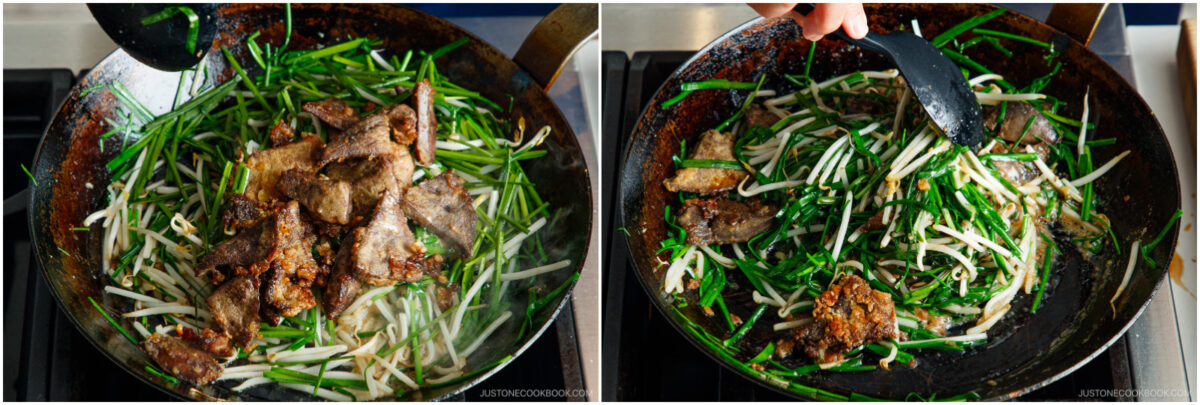
Toss everything together quickly. Transfer to a serving plate.
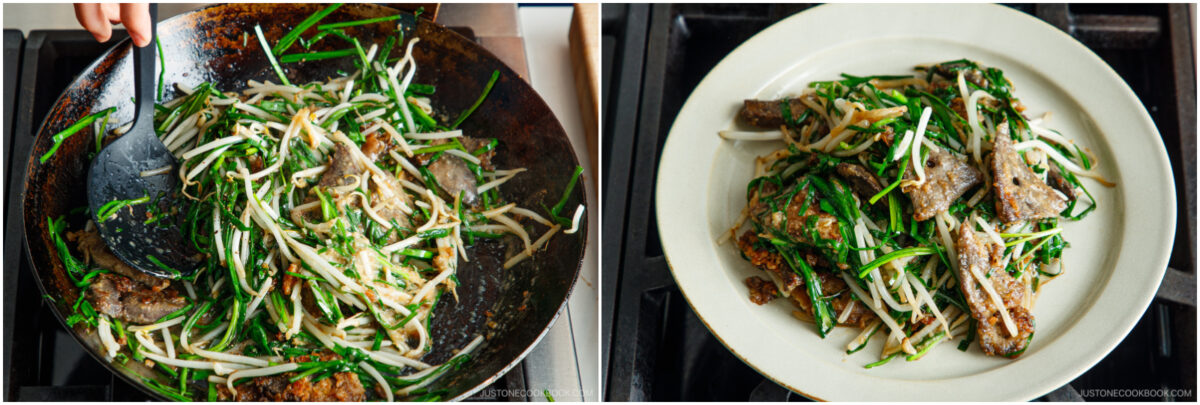
To Serve
Serve immediately with optional white pepper powder at the table. Nami's Tip: The vegetables lose their crunch if they sit too long. If you like them crisp, serve the dish right away.
To Store
Liver is highly perishable, so it’s best to eat it as soon as possible. Let the dish cool completely, then transfer to an airtight container. Store in the fridge for up to 1–2 days. Reheat in a frying pan over medium-high heat for a quick stir to avoid sogginess. Liver tends to become tough after freezing, so I don't recommend it.
Did you make this recipe?
Tag @justonecookbook on Instagram so we can see your delicious creation!






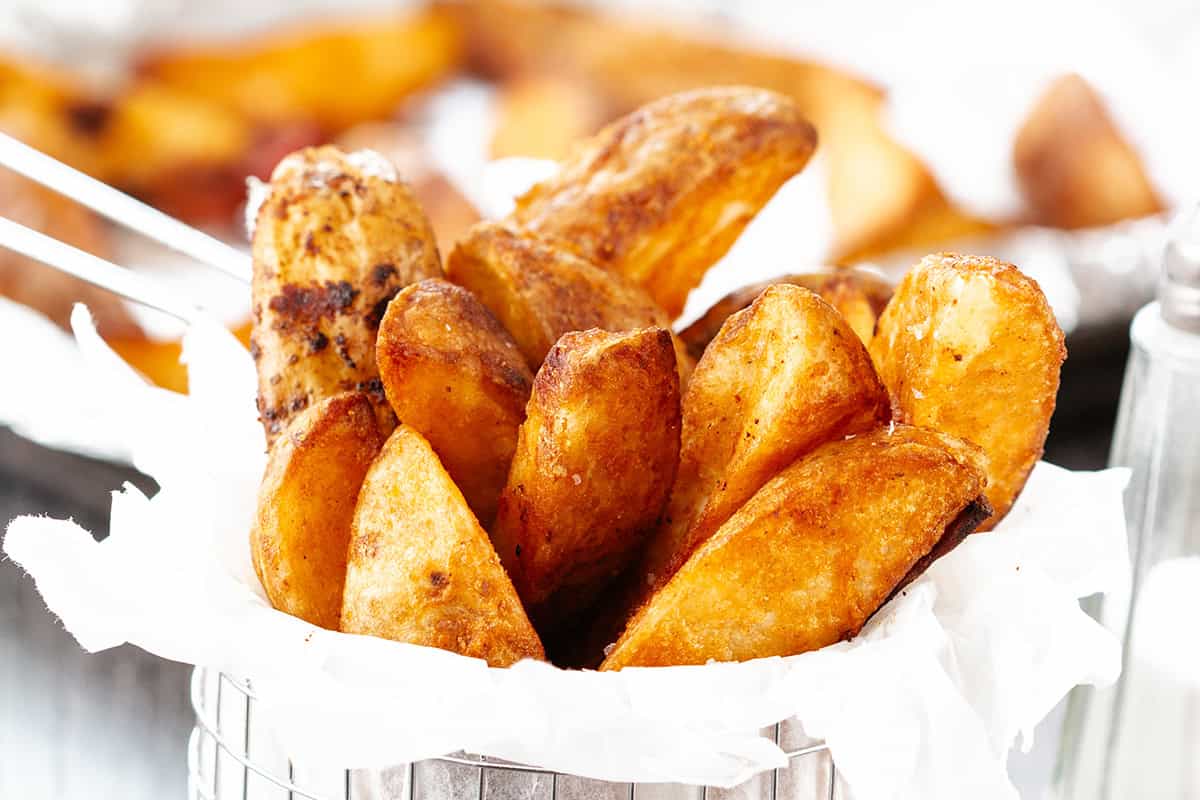
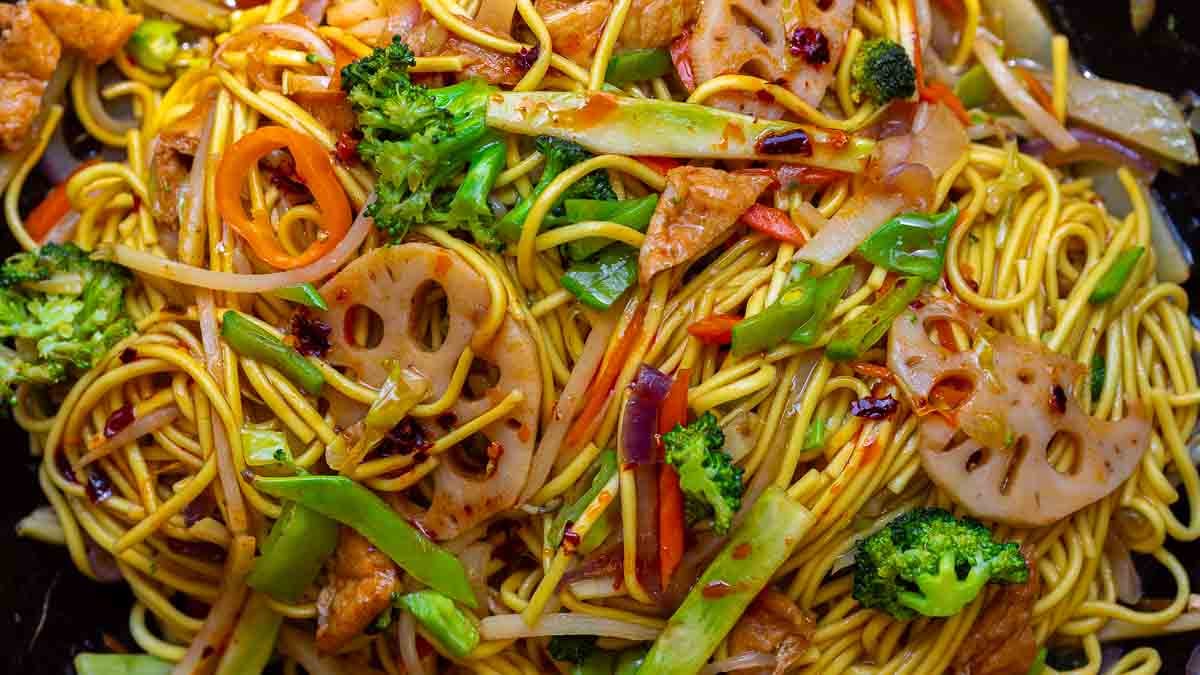
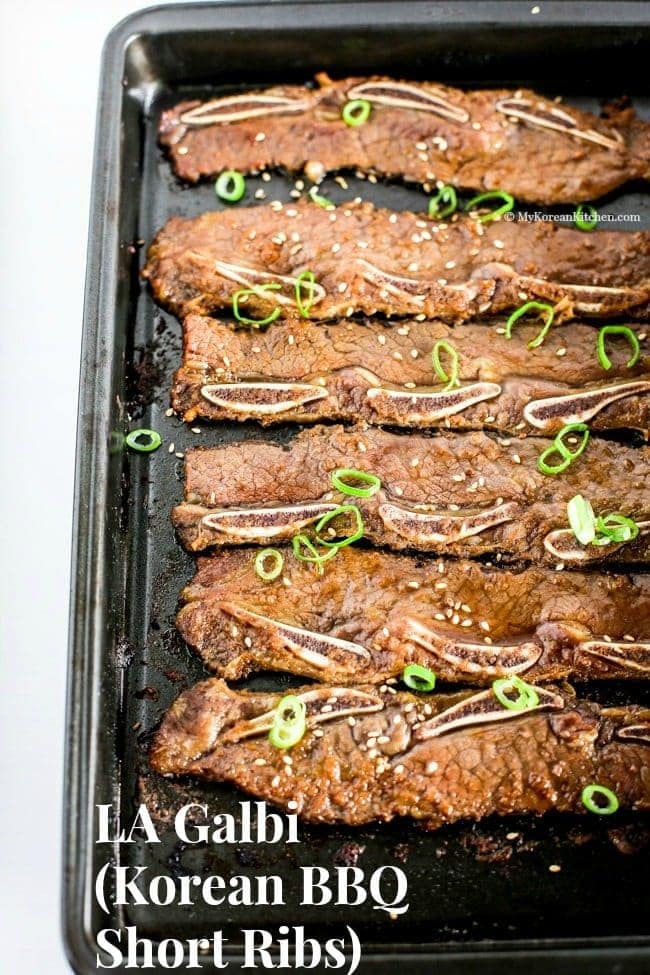

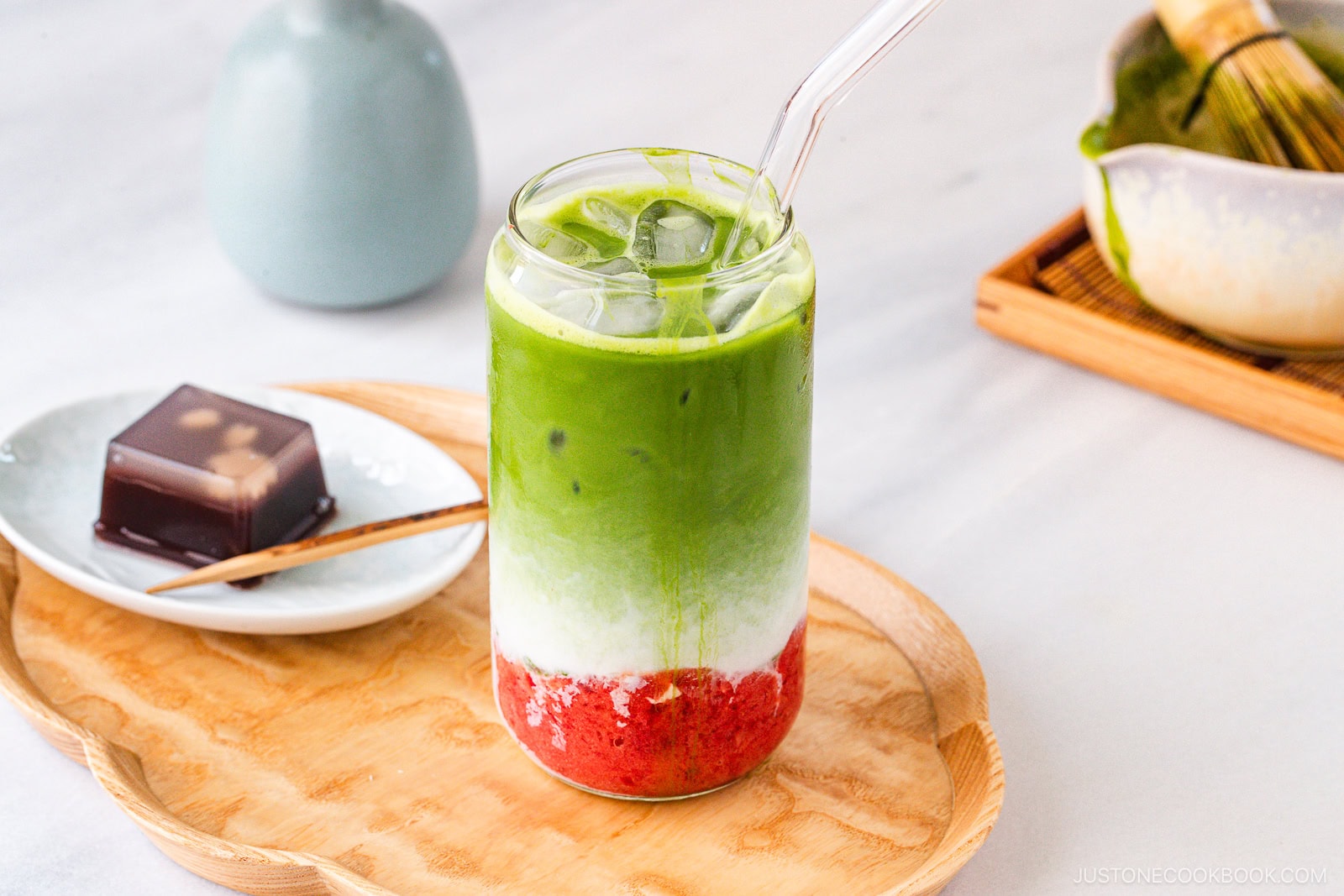
 English (US) ·
English (US) ·